 04/11/2009 20:20 04/11/2009 20:20 |
|
| | | OFFLINE | | Post: 18.796
Post: 1.444 | Registrato il: 28/08/2005
Registrato il: 20/01/2009 | Administratore | Utente Veteran | |
|

 GENERAL AUDIENCE TODAY
GENERAL AUDIENCE TODAY
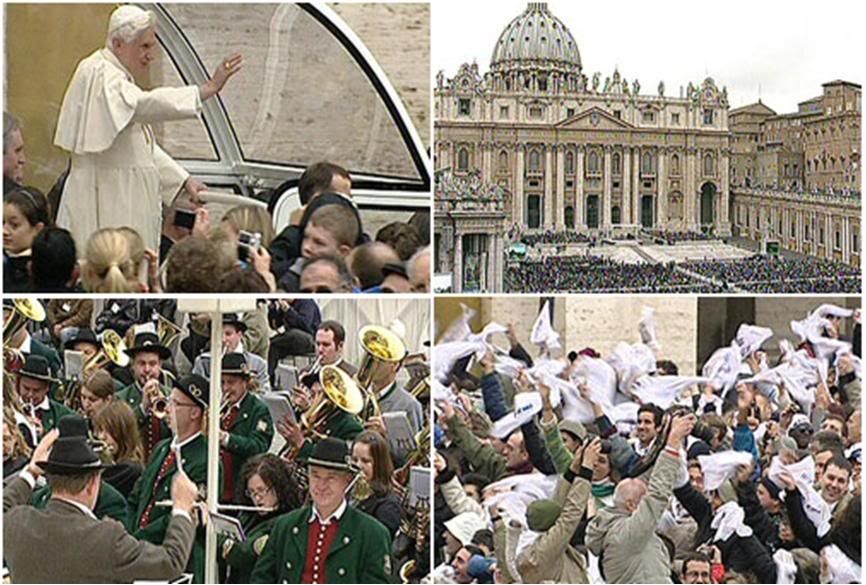
Continuing with his catechesis on the development of theology in the High Middle Ages, Pope Benedict XVI devoted his discourse at the General Audience today to a comparison between 'theology of heart' and 'theology of reason', as exemplified by Bernard of Clairvaux and Abelard of Paris.
Here is how the Holy Father synthesized it in English:
Today we continue our comparison of the monastic and scholastic approaches to theology which we began last week, by looking again at Saint Bernard of Clairvaux, this time in comparison with Abelard.
Both of them considered theology as "faith seeking understanding"; but whereas Bernard placed the accent on "faith", Abelard emphasized "understanding".
Bernard, for whom the aim of theology was to have a living experience of God, cautioned against intellectual pride which makes us think we can grasp fully the mysteries of faith.
Abelard, who strove to apply the insights of philosophy to theology, saw in other religions the seeds of an openness to Christ.
The respective approaches of Bernard and Abelard — one a "theology of the heart" and the other a "theology of reason" — were not without tension. They therefore illustrate the importance of healthy theological discussion and humble obedience to ecclesial authority.
Theology must respect the principles it receives from revelation as it uses philosophy to interpret them. Whenever a theological dispute arises, everyone, and in a particular way the Magisterium, has a responsibility to safeguard the integrity of the faith.
As we strive to deepen our understanding of the Gospel, may God strengthen us to extol its truth in charity.
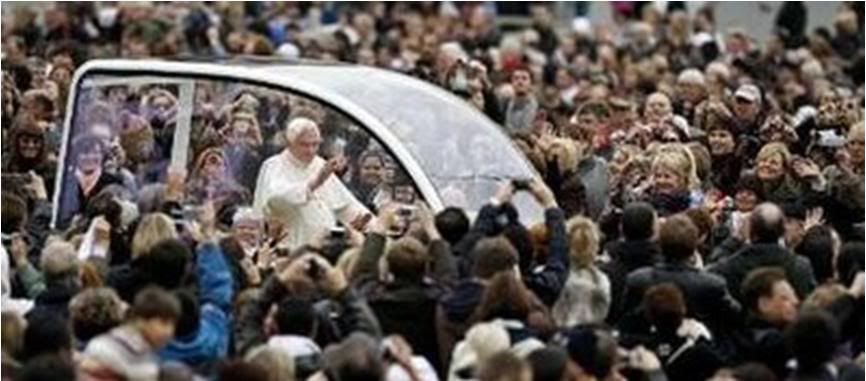
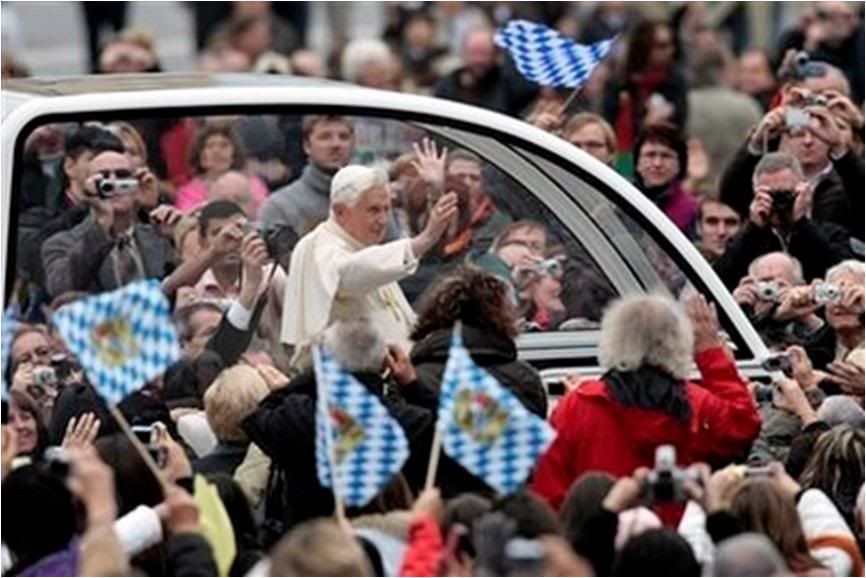 Here is a translation of the Holy Father's full catechesis:
Here is a translation of the Holy Father's full catechesis:
BERNARD AND ABELARD:
Theology of the heart
vs theology of reason
In the last catechesis, I presented the principal characteristics of monastic theology and scholastic theology in the 12th century, which we could call, in a certain sense, 'theology of the heart' and 'theology of reason', respectively.
There arose an ample and sometimes heated debate between the representsatives of one and the other theological current, symbolically represented by the controversy between St. Bernard of Clairvaux and Abelard.
To understand this confrontation between the two great teachers, it will help to remember that theology is the search for a rational comprehension, to the extent is is possible, of the mysteries of Christian revelation, believed through faith: Fides quaerens intellectum – faith seeks intelligibility - to use a traditional
definition that is concise and effective.
Now, while St. Bernard, typical representative of monastic theology, stressed the first part of the definition, namely fides, faith, Abelard, who was a scholastic, insisted on the second part, namely, on intellectus, understanding through reason.
For Bernard, faith itself is endowed with an intimate certainty, based on the testimony of Scripture and the teachings of the Fathers of the Church. Moreover, faith is reinforced by the testimony of the saints and by the inspiration of the Holy Spirit into the soul of individual believers.
In case of doubts and ambiguity, faith is protected and illuminated by the exercise of ecclesial Magisterium. Thus, Bernard found it difficult to agree with Abelard, and more generally, with those who would subject the truths of the faith to the critical examination of reason.
In his view, such an examination carried a grave danger, namely, intellectualism, the relativization of truth, placing the very truth of the faith under discussion. Bernard saw in such a procedure a daring drive which could lead to unscrupulousness, fruit of the arrogance of human intelligence that would claim to 'capture' the msytery of God.
In one of his letters, he wrote sorrowfully: "Human ingenuity is making itself the master of everything, leaving nothing to faith. It confronts that which is above it, it scrutinizes that which is superior, and that which it finds itself unable to follow, it considers null, and refuses to believe it" (Epistola CLXXXVIII,1: PL 182, I, 353).
For Bernard, theology had only one purpose: to promote the living intimate experience of God. Theology thus helps to love God ever more and even better, as expressed in the title of his tract on the duty to love God (De diligendo Deo).
Along this way, there are several steps, which Bernard describes in depth, culminating when the soul of the believer finds itself inebriated on the peaks of love. The human soul can reach this mystical union with the divine Word while still on earth, a union that the Dottor Mellifluus describes as 'spiritual wedding'.
The divine Word visits the soul, eliminates its last resistances, illumines, inflames and transforms it. In such a mystical union, the soul experiences a great serenity and tenderness, and sings to her Spouse a hymn of joy.
As I recalled in the catechesis dedicated to the life and doctrine of St. Bernard, theology for him could only nourish itself in contemplative prayer - in other words, by the affective union of heart and mind with God.
Abelard - who, among other things, had introduced the term 'theology' in the sense that we understand it today - had a different perspective. Born in Brittany, in France, this famous 12th century teacher was gifted with a lively intelligence, and his vocation was study.
He occupied himself with philosophy first, and then applied the results he acquired from that discipline to theology, which he taught in the must cultured city of his time, Paris, and subsequently, in the monasteries where he lived.
He was a brilliant orator: his classes were followed by crowds of students. A religious spirit but an unsettled personality, his life was rich with dramatic episodes: he questioned his own teachers, and he had a son by Heloise, a cultured and intelligent woman.
He often engaged in polemics with his fellow theologians, and even underwent ecclesiastical condemnation, alghough he died in full communion with the Church, to whose authority he submitted himself in the spirit of faith.
St. Bernard himself contributed to the condemnation of some doctrines of Abelard in the provincial Synod of Sens in 1140, in which he even sought the intervention of Pope Innocent II. The abbot of Clairvaux questioned, as we recalled, Abelard's too intellectualistic method which, in his eyes, reduced the faith to a simple opinion detached from revealed Truth.
Bernard's fears were not unfounded and were in fact shared by other great thinkers of the time. In effect, excessive use of philosophy rendered Abelard's doctrine of the Trinity dangerously fragile, and thus, too, his idea of God.
In the moral field, his teaching was not devoid of ambiguity: He insisted on considering the intention of the subject as the only basis for describing goodness or evil in moral acts, thus ignoring the objective significance and moral value of actions - a dangerous subjectivism.
This, as we know, is an aspect that is very actual in our time, in which culture often seems to be marked by a growing tendency to ethical relativism: only my ego decides what is good for me, at any time.
Nonetheless, we must not forget the great merits of Abelard, who had many disciples and definitely contributed to the development of scholastic theology that was destined to express itself in a more mature and fecund manner in the next century.
Nor must we undervalue some of his intuitions as, for example, when he stated that in the non-Christian religious traditions, there already is a preparation to welcome Christ, the divine Word.
What then can we today learn from the confrontation - often in heated tones - between Bernard and Abelard, and in general, between monastic theology and scholastic theology?
Above all, I think that it shows the usefulness and the need for a healthy theological discussion within the Church, especially when the
questions to be discussed have not been defined in the Magisterium, which nonetheless, remains an unavoidable reference point.
St. Bernard - and even Abelard himself - always unhesitatingly recognized the authority of the Magisterium. Moreover, the condemnations undergone by the latter remind us that in the theological field, there should be an equilibrium between what we might call the architectonic principles given to us by Revelation and which therefore retain priority importance, and the interpretative principles suggested by philosophy, namely, by reason, which have an important function but merely as tools.
When such an equilibrium between architecture and tools is not observed, theological reflection risks being spoiled by errors, and it then falls to the Magisterium to exercise that necessary service to truth which is proper to it.
Besides, we must point out that among the reasons that led Bernard to range himself with those against Abelard and to solicit the intervention of the Magisterium, was his concern to safeguard simple and humble believers, who must be defended when they are in danger of being confused or misled by theological opinions that are too personal or by unscrupulous theological arguments which could undermine their faith.
I wish to recall, finally, that the theological confrontation between Bernard and Abelard ended with full reconciliation between the two, thanks to the mediation of a mutual friend, the Abbot of Cluny, Peter the Venerable, about whom I spoke in a recent catechesis.
Abelard showed humility in acknowledging his errors and Bernard showed great benevolence. In both of them, what prevailed was that which must be taken to heart when a theological controversy is born - namely, to safeguard the faith of the Church and allow truth in charity to triumph.
May this be the attitude today of those who dispute within the Church, who must always have the search for Truth as their goal.
The Holy Father is obviously addressing the Lefebvrians as well as dissident Catholic theologians with this catechesis, while reiterating his own guiding principle as theologian, archbishop, Prefect of the CDF and Pope - to safeguard the faith in behalf of the simple folk who believe primarily and implicitly on faith alone.
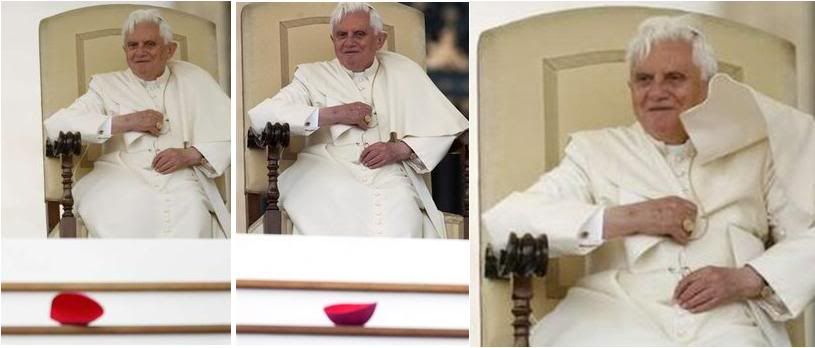 The Holy Father, who is often at the receiving end of 'wind effects', reacts with sympathetic amusement to a bishop's cap landing at his feet.
The Holy Father, who is often at the receiving end of 'wind effects', reacts with sympathetic amusement to a bishop's cap landing at his feet.
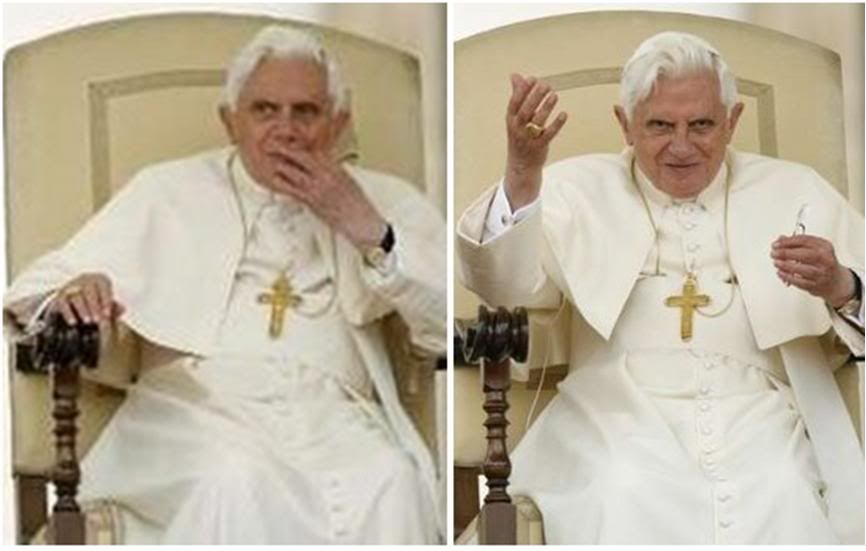

 Sidelights at the GA today
Translated from
Sidelights at the GA today
Translated from
the 11/5/09 issue of

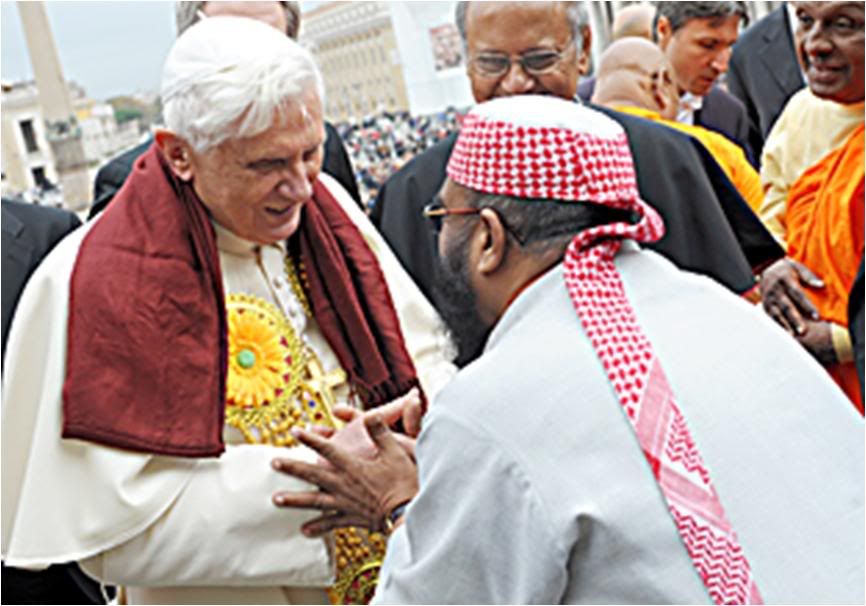
Leaders of various religions in Sri Lanka presented a joint statement expressing their desire for peace in their country to Pope Benedict XVI.
"With particular emphasis on the situation of refugees and necessary economic assistance" after more than three decades of civil war, according to Mons. Albert Malcolm Ranjith, Archbishop of Colombo, who is accompanying the delegation on a European tour to focus international attention on the plight of the victims of the long war.
The delegation met yesterday with Cardinal Tarcisio Bertone. Secretary of state. They are scheduled to visit European Union headquarters in Brussels, and the foreign ministries in Paris and London.
***
At the end of the General Audience today, a Nigerian girl recently liberated from the slavery of prostitution presented the Pope with stories of pain and hope of "the poor, the disabled, lonely and desperate persons" who together give life to the Comunità Giovanni XXIII.
Two years since the death of the community's founder, Don Oreste Benzi, "three thousand of us have come to testify that our work of charity is all done in the heart of the Church," said the group's leader, Giovanni Paolo Ramonda.
***
And it was to tell the Pope about their own work of charity "realized in justice and with scientific competence" that officials of the Oasi Federico came from Calabria, southern Italy.
They have set up a Benedict XVI Center to educate disabled young people to be productive, using innovative methods of instruction.
"We offered this pioneering center as a gift to the Pope and have invited him to visit us," said Matilde Leonardi, who heads the Center's scientific committee.
***
The ecumenical activity of the St. Clement Center in Kiev, capital of the Ukraine, was described to the Pope by its director Konstantin Sigoc and Fr. Filaret Egorov from the Moscow Patriarchate. They said the center "promotes a Christian cultural project that is tailored for the reality of a post-Communist nation".
***
The mayor of Bucharest, Romania, assured the Pope that his administration was working to preserve a Catholic cathedral that is threatened by the construction of a new skyscrapter.
***
Also present at today's audience were the mayor and parish priest of the Pope's birthplace, Marktl am Inn.
[Modificato da TERESA BENEDETTA 05/11/2009 17:56] |
| |
|
| |
 05/11/2009 12:38 05/11/2009 12:38 |
|
| | | OFFLINE | | Post: 18.798
Post: 1.446 | Registrato il: 28/08/2005
Registrato il: 20/01/2009 | Administratore | Utente Veteran | |
|
 Thursday, Nov. 5
Thursday, Nov. 5
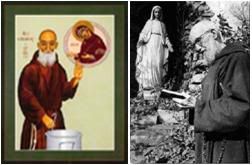 VENERABLE SOLANUS CASEY (USA, 1870-1957)
VENERABLE SOLANUS CASEY (USA, 1870-1957)
Capuchin Priest, Candidate for Beatification
The first US-born man to be named Venerable, Fr. Casey
was the son of Irish immigrants who did several odd
jobs before he entered high school at age 21. Ordained
a Capuchin at age 33, he was not allowed to preach or
hear confessions because of a poor academic record at
the seminary. In 1924, he became porter-receptionist
at St. Bonaventure monastery in Chicago until he died,
distinguishing himself by his great faith, humility, and
role as spiritual counselor and intercessor. He was
declared Venerable in 1995 by John Paul II.
OR today.

At the General Audience, the Pope discusses the controversy between St. Bernard and Abelard and calls for
Healthy theological discussion within the Church
Other Page 1 stories: An editorial commentary on a European court ruling that the presence of the Cross in Italian public schoolrooms
is a human rights violation; Cardinal Bertone deplores the ruling; and in Tehran, police disperse protestors recalling the 30th anniversary
of the Iranian takeover of the US embassy which resulted in 53 Americans being held hostage for 444 days by Islamist militants.
The inside pages contain two articles on St. Carlo Borromeo on the 400th anniversary year of his canonization - a homily by the Archbishop
of Milan on the importance of priestly celibacy, and an article by Christian art expert Timothy Verdon on a Milan exhibit of paintings
illustrating the life of the saint, whose liturgical feast the Church commemorated yesterday.
NB: Page 1 reproduces a cartoon in the Nov. 3 issue of Corriere della Sera showing Christ saying "Once again, they have voted for Barabbas'.
THE POPE'S DAY
The Holy Father presided today at a Mass in St. Peter's Basilica to commemorate the cardinals and bishops
who died in the past 12 months.
****
A news conference was held at the Vatican Press Office on the coming Nov. 21 meeting of Pope Benedict XVI
with artists from around the world at the Sistine Chapel.
[Modificato da TERESA BENEDETTA 05/11/2009 12:39] |
| |
 05/11/2009 13:48 05/11/2009 13:48 |
|
| | | OFFLINE | | Post: 18.799
Post: 1.447 | Registrato il: 28/08/2005
Registrato il: 20/01/2009 | Administratore | Utente Veteran | |
|
 The European court ruling this week declaring the presence of the Cross in Italian schoolrooms as a violation of human rights is not directly related to the Holy Father, but it is such a landmark event in the de jure secularization of Europe - against which Benedict XVI has been the most persistent paladin for decades - that I am posting here the L'Osservatore Romano commentary on it. I first posted news of the ruling - and the complete English text of the court's announcement - in the ISSUES thread on Tuesday, and the first Vatican reaction in the CHURCH&VATICAN thread.
The European court ruling this week declaring the presence of the Cross in Italian schoolrooms as a violation of human rights is not directly related to the Holy Father, but it is such a landmark event in the de jure secularization of Europe - against which Benedict XVI has been the most persistent paladin for decades - that I am posting here the L'Osservatore Romano commentary on it. I first posted news of the ruling - and the complete English text of the court's announcement - in the ISSUES thread on Tuesday, and the first Vatican reaction in the CHURCH&VATICAN thread.
 The Crucifix, the judges
The Crucifix, the judges
and Natalia Ginzburg
by Giuseppe Fiorentino and Francesco M. Valiante
Translated from
the 11/05/09 issue of

The judgment issued yesterday by the European Court of Human Rights in Strasbourg - which would prohibit the display of the Cross in Italian schoolrooms because it would violate the right of parents to educate their children according to their convictions as well as the right of children to religious freedom - has struck the symbol that most represents the great tradition, not simply religious, of the European continent.
"The Crucifix does not generate any discrimination. Say no more! It is the image of the Christian revolution which spread throughout the world the idea of equality among all men which had been absent until then".
That was written by Natalia Ginzburg [1916-1991, Italian Jewish novelist] on March 22, 1988, in the pages of L'Unita, the newspaper founded by Antonio Gramsci as the organ of the Italian Communist Party.
The words of the writer, from a distance of 20 years, express a sentiment that continues to be widely shared in Italy, made evident by the many reactions to the judgment of the court in Strasbourg.
While the Italian government has said that it will appeal the judgment, the political world has almost unanimously condemned the lack of common sense shown by the court, in pointing out that the secularity of institutions is something other than negating the role of Christianity in European history.
"Surprise and sorrow" were expressed by the press director of the Holy See, Fr. Federico Lombardi, in a statement first transmitted on Vatican Radio and on state TV's TG-1.
"It is a serious matter," he said, "to emarginate from the world of education a fundamental symbol of the importance of religious values in Italian history and culture."
He continued: "It also is surprising that a European court is intervening so heavily in a matter that is deeply tied to the historic, cultural and spiritual identity of the Italian people. It is not the way to make the idea of Europe [as a political entity] more attractive and shared, an idea that Italians have always supported from the very beginning".
It is sad that it is being considered a sign of division, exclusion or limitation of freedom. That is not what it is and that is not the common feeling of our people."
The Italian bishops' conference (CEI) denounced the court's 'biased and ideological view', saying the decision "ignores the multiple meanings of the Cross, which is not only a religious symbol but also a cultural sign".
it must be remembered that in Italy, the Council of State declared legitimate in 2006 all norms that provide for the display of the Crucifix in Italian schoolrooms, saying it did not represent discrimination against non-believers because "it represents values which are civically relevant and more important, values which underlie and inspire our constitutional order".
In effect, the judgment by the Strasbourg court, which claims to protect all human rights, places into question the roots on which those same rights were based, denying the importance of the role of religion - of Christianity, in particular - in the construction of European identity and in affirming the centrality of man in society.
Seen another way, the decision of the seven judges in Strasbourg seems to be inspired by an idea of state secularity which would marginalize the contribution of religion to public life.
One can thus foresee a not-too-distant future with a public environment devoid of any religious and cultural reference for fear of offending someone's sensibility.
In fact, it is not in the negation but in the acceptance and respect for diverse identities that one defends the idea of a secular State and one can favor integration among various cultures.
"The Cross represents everyone," wrote Ginzburg, because "before Christ, no one had ever said that all men are equal, and brothers, rich and poor, believers and non-believers, Jews and Gentiles, black and white."
The newspaper also carried a brief reaction from Cardinal Bertone:
Cardinal Bertone:
'A true loss'
Translated from
the 11/05/09 issue of

Rome, Nov, 4 - "This Europe of the third millennium leaves us only with the pumpkins of Halloween and would take away our dearest symbols".
This was the comment of Cardinal Tarcisio Bertone, Vatican Secretary of State, on the ruling from the Strasbourg court on the presence of the Cross in Italian schoolrooms.
"This is truly a loss. We should strive with all our powers to conserve the symbols of our faith for believers as well as non-believers," he continued. [The statement does not make sense. In declaring it 'a true loss', he seems to be accepting it as immutable fact - and how does one conserve 'the symbols of our faith' even for non-believers?]
After expressing 'appreciation' for the initiative of the Italian government, which announced it would take action against the decision, the cardinal said the Cross "is a symbol of universal love, a sign of acceptance and not of exclusion".
"I have to question whether this judgment is a sign of reasonableness at all," he concluded.
[Rather weak words for a first reaction from the #2 man at the Vatican!]
Avvenire has a good roundup of reactions, which I will post when translated, but first, Reuters has a wrap-up in English:
Italy and Vatican in uproar
over court crucifix ruling
By Philip Pullella

ROME, Nov. 4 (Reuters) – The European Court of Human Rights ruled on Tuesday that crucifixes should be removed from Italian classrooms, prompting Vatican anger and sparking uproar in Italy, where such icons are embedded in the national psyche.
"The ruling of the European court was received in the Vatican with shock and sadness," said Vatican spokesman Father Federico Lombardi, adding that it was "wrong and myopic" to try to exclude a symbol of charity from education.
The ruling by the court in Strasbourg, which Italy said it would appeal, said crucifixes on school walls -- a common sight that is part of every Italian's life -- could disturb children who were not Christians.
Italy has been in the throes of national debate on how to deal with a growing population of immigrants, mostly Muslims, and the court sentence is likely to become another battle cry for the center-right government's policy to restrict newcomers.
"This is an abhorrent ruling," said Rocco Buttiglione, a former culture minister who helped write papal encyclicals.
"It must be rejected with firmness. Italy has its culture, its traditions and its history. Those who come among us must understand and accept this culture and this history," he said.
The Vatican spokesman said it was sad that the crucifix could be considered a symbol of division and said religion offered a vital contribution to the moral formation of people.
Members of Prime Minister Silvio Berlusconi's government bristled, weighing in with words such as "shameful," "offensive," "absurd," "unacceptable," and "pagan."
Foreign Minister Franco Frattini said the court had dealt a "mortal blow to a Europe of values and rights," adding that it was a bad precedent for other countries.
Condemnation crossed party lines. Paola Binetti, a Catholic in the opposition Democratic Party, the successor of what was once the West's largest communist party, said: "In Italy, the crucifix is a specific sign of our tradition."
The case was brought by an Italian national, Soile Lautsi, who complained that her children had to attend a public school in northern Italy which had crucifixes in every room.
Education Minister Mariastella Gelmini said crucifixes on the walls of tens of thousands of classrooms "do not mean adherence to Catholicism" but are a symbol of Italy's heritage.
"The history of Italy is marked by symbols and if we erase symbols we erase part of ourselves," Gelmini said.
Lautsi, the woman who filed the suit, said crucifixes on walls ran counter to her right to give her children a secular education and the Strasbourg-based court ruled in her favor.
"The presence of the crucifix ... could be encouraging for religious pupils, but also disturbing for pupils who practiced other religions or were atheists, particularly if they belonged to religious minorities," the court said in a written ruling.
"The State (must) refrain from imposing beliefs in premises where individuals were dependent on it," it added, saying the aim of public education was "to foster critical thinking."
At least one Muslim girl disagreed with the court.
"If the crucifix is there and I am a Muslim I will continue to respect my religion. Jesus in the classroom doesn't bother me," Zenat, a 14-year-old girl of Egyptian origin, told Reuters Television.
Two Italian laws dating from the 1920s, when the Fascists were in power, state that schools must display crucifixes. [These norms were upheld as recently as 2006 by the Italian Coucnil of State.]
Alessandra Mussolini, granddaughter of Fascist dictator Benito Mussolini, said rulings such as that by the court were leading to "a Europe without an identity."
Only a handful of politicians defended the court, including some members of the Democratic Party, as well as members of the communist party and atheist groups.
The story does not include the reaction from Prime Minister Silvio Berlusconi, who said the decision was "absolutely unexpected, unforeseen and unacceptable".
Berlusconi continued: "It is one of thoser decisions that maes one doubt if there is any common sense in Europe... Italy is a country where we cannot possibly say we are not Christian". [From the Avvenire report].
P.S. Sorry... It tiruns out Reuters filed a separate story that leads off with Berlusconi's reaction.
Berlusconi says crucifix ruling
denies Europe's roots
By Stephen Brown

ROME, Nov. 4 (Reuters) - Italy's Silvio Berlusconi said on Wednesday a European Court of Human Rights ruling that called for crucifixes to be removed from Italian classrooms was a nonsensical attempt to deny Europe's Christian roots.
The Roman Catholic country has reacted with outrage to Tuesday's ruling from Strasbourg that the ubiquitous crucifixes on walls in Italian schools could disturb children who were not Christian.
The conservative prime minister, who draws much of his support from the Roman Catholic majority, told a television show the ruling was an attempt to "deny Europe's Christian roots. This is not acceptable for us Italians."
Berlusconi pointed out that Italy has so many churches that "you only have to walk 200 meters forwards, backwards, to the right or to the left, and you find a symbol of Christianity."
"This is one of those decisions that often make us doubt Europe's good sense," said the prime minister, confirming that Italy intended to appeal against the ruling once his cabinet has studied it at its weekly meeting on Friday.
The Vatican expressed "shock and sadness" at the court ruling, which was condemned across the ideological divide in a rare moment of unity among Italian politicians. Only some on the far left and atheist groups backed the ruling.
Mayors all over the country vowed to defy the ruling and there were angry reactions from Catholic strongholds abroad such as Poland. Thousands of people protested on social networking sites on the Internet.
"Europe in the third millennium is leaving us only Halloween pumpkins while depriving us of our most beloved symbols," said Vatican number two, Cardinal Tarcisio Bertone.
Italy has been in the throes of debate on how to deal with a growing population of immigrants, mostly Muslims, and the ruling could become another battle cry for the government's policy drive to crack down on new arrivals.
Mara Bizzotto, a European parliamentarian for Berlusconi's anti-immigrant coalition partner, the Northern League, asked why the European court had taken action against the crucifix but did not ban Muslim symbols such as "veils, burqas and niqabs."
As I posted in the CHURCH&VATICAN thread yesterday, the absurdity and sheer ignorance of the Strasbourg court's ruling on the Cross was pointed out by Massimo Introvigne who says the original complainant, an Italian lady married to a Finn, should, by her own logic, go home to Finland and demand that her adopted country change its flag - I did the research to show how many countries in Europe have the cross as the main feature of their respective national flags:
Left photo, flag of Finland. In fact, the Nordic cross is the characteristic of all five Scandinavian flags.
Right photo, from left: Finland, Iceland, Norway, Sweden, Denmark.

Other European flags with the cross: From left, Greece, the UK, Georgia, Slovakia, and Switzerland.
 And what if some nut now lodges a suit with the Strasbourg court to question the crosses on all these flags? Will that court then compel them to revoke part of their national history and replace their flags???? This is absolute lunacy.
And what if some nut now lodges a suit with the Strasbourg court to question the crosses on all these flags? Will that court then compel them to revoke part of their national history and replace their flags???? This is absolute lunacy.
What the Strasbourg court demonstrates - besides its anti-Christian bigotry and bookish literalness in interpreting human rights - is ignorance of human history, in which after the circle, the cross has been one of the most universal signs even in pre-Christian cultures. Just consider the Egyptian ankh or even the Celtic cross!
[Modificato da TERESA BENEDETTA 05/11/2009 18:52] |
| |
 05/11/2009 17:36 05/11/2009 17:36 |
|
| | | OFFLINE | | Post: 18.800
Post: 1.448 | Registrato il: 28/08/2005
Registrato il: 20/01/2009 | Administratore | Utente Veteran | |
|
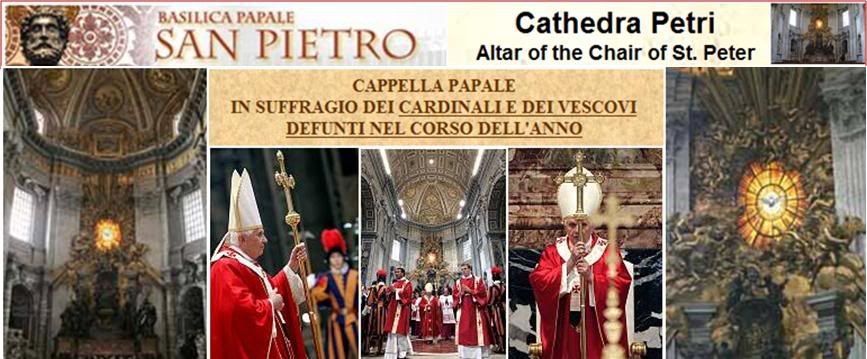 COMMEMORATIVE MASS FOR
COMMEMORATIVE MASS FOR
CARDINALS & BISHOPS
DECEASED IN THE PAST YEAR
Translated from
the 11/6/09 issue of

At 11:40 on Thusrday morning, Pope Benedict XVI presided at a Mass celebrated at the Altar of Peter's Chair in the Vatican Basilica to commemorate the cardinals and bishops who have died in the past year.
"Faithful servants, whom the master, returning from a wedding, found wakeful and vigilant."
With these words taken from the Gospel of Luke, Benedict XVI remembered the deceased prelates during the concelebrated Mass of homage.
Seven cardinals died between Dec. 12, 2008, and July 17, 2009 - Avery Dulles, Pio Laghi, Stéphanos ii Ghattas, Stephen Kim Sou-Hwan, Paul Joseph Pham Ðình Tung, Umberto Betti and Jean Margéot. One hundred archbishops and bishops died from October 22, 2008 to October 26, 2009.
Prayers were also offered for the intentions of the Pope and for the pastors of the Church.
Concelebrating with the Pope at the Altar of Peter's Chair were 34 cvardinals, including Cardinals Tarcisio Bertone, Secretary of State, and Angelo Sodano, dean of the College of Cardinals. Also present were priests and prelates from the Roman Curia.
Sitting with the diplomatic corps to the Holy See were Archbishops Dominique Mamberti and Fernando Filoni, deputy Secretaries of State for external relations and for internal affairs, respectively; along with Monsignors Ettore Balestrero, undersecretary to Mamberti; Fptunatus Nwachukwu, chief of protocol at State; and Peter Brian Wells, senior counselor and undersecretary to Filoni.
The Pope processed into the Basilica with Archbishop James Harvey, Prefect of the Pontifical Household; Mons. Félix del Blanco Prieto, Almoner; Mons. Paolo De Nicolò, regent to Mons Harvey; and teh Pope's two private secretaries, Monsignors Georg Gänswein and Alfred Xuereb.
The liturgical music was provided by the choir of the Cappella Giulia.
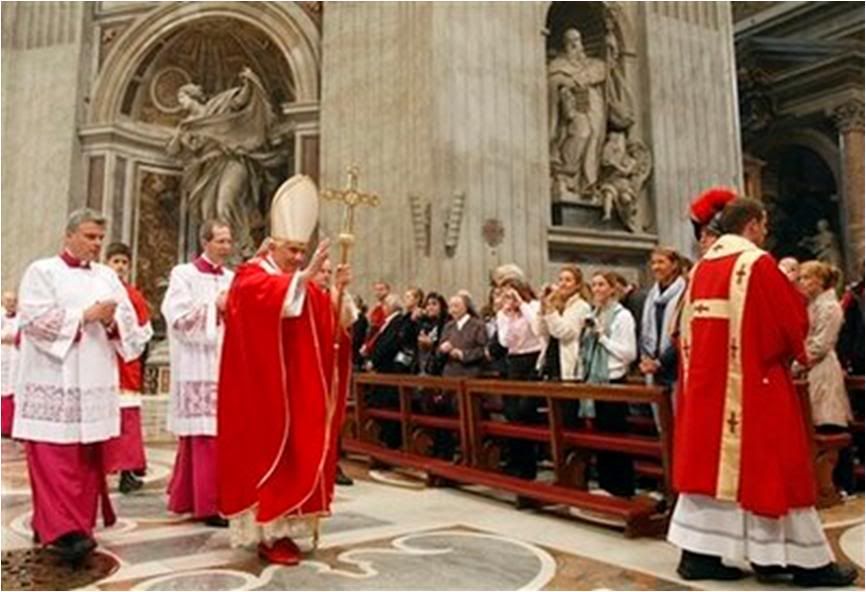
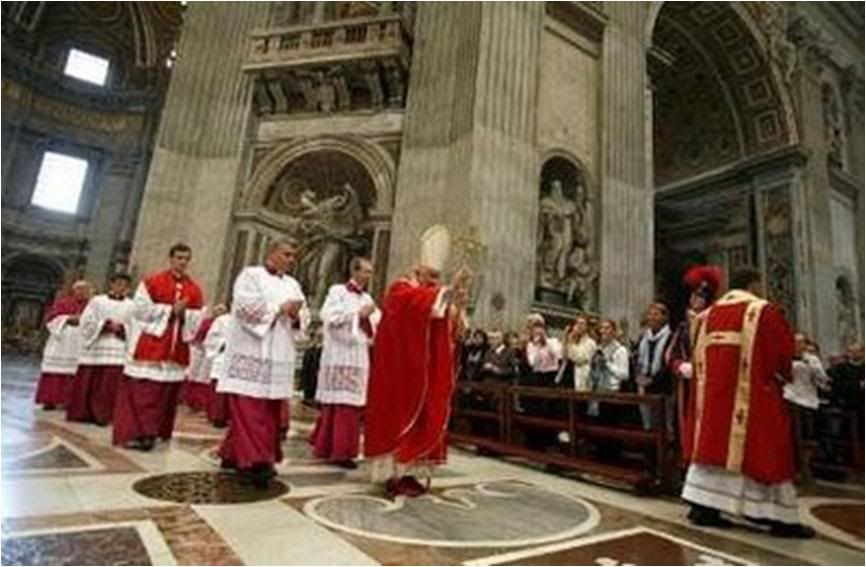

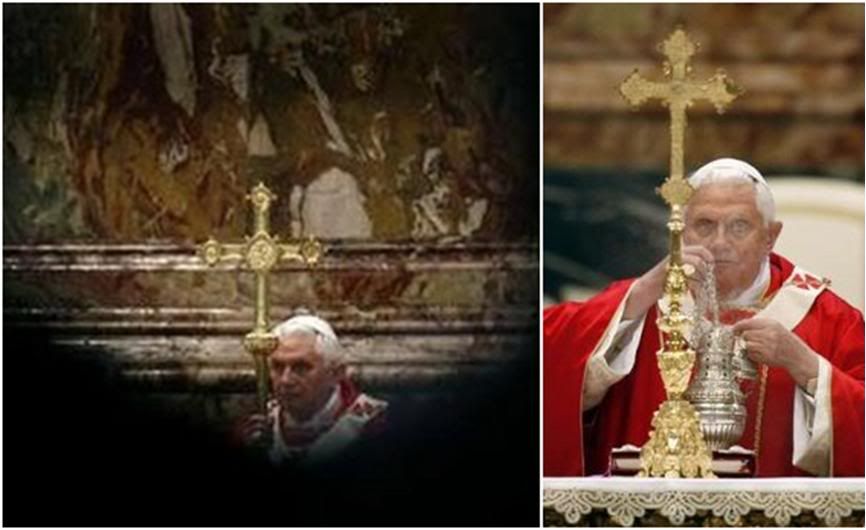
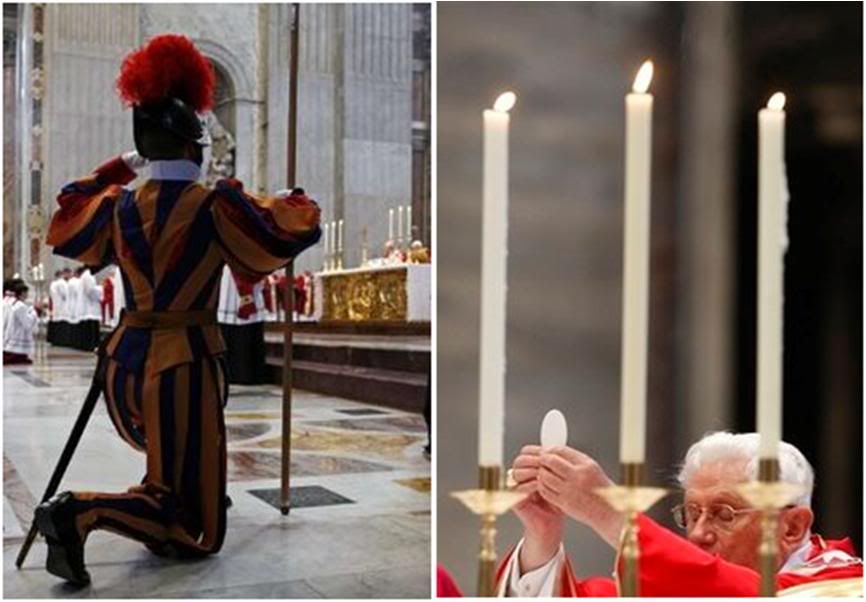
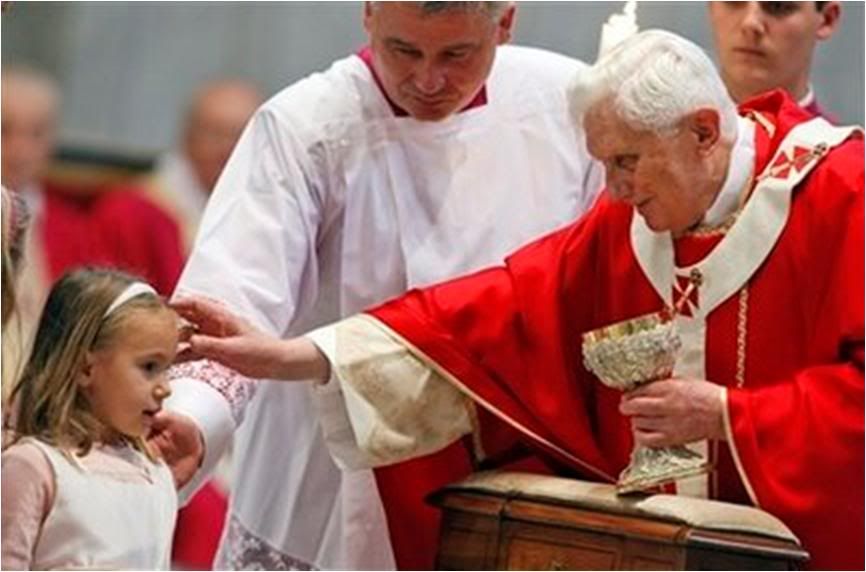
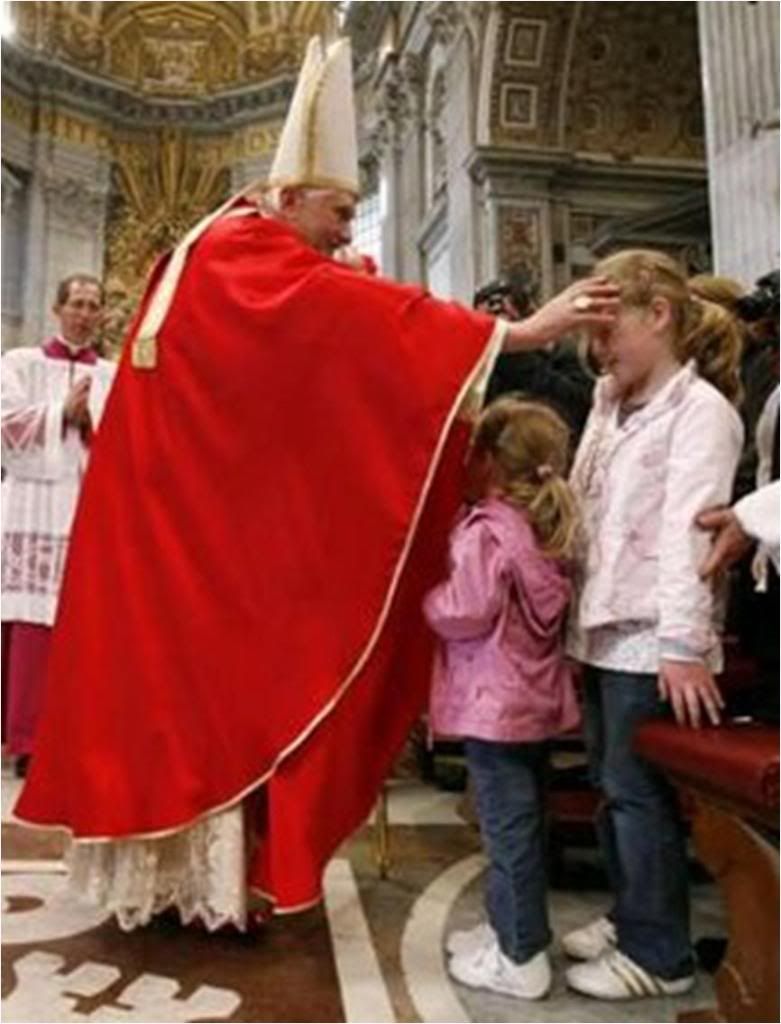 Will post homily when translated.
Will post homily when translated.
[Modificato da TERESA BENEDETTA 05/11/2009 22:20] |
| |
 05/11/2009 18:12 05/11/2009 18:12 |
|
| | | OFFLINE | | Post: 18.801
Post: 1.449 | Registrato il: 28/08/2005
Registrato il: 20/01/2009 | Administratore | Utente Veteran | |
|
 Pope's Anglican offer accepted
Pope's Anglican offer accepted
by UK wing of the Traditional Anglican Communion

Nov. 5, 2009
The UK wing of the Traditional Anglican Communion – a group of rebel traditionalists who have left official Anglicanism – has voted to accept Pope Benedict XVI’s offer of a Personal Ordinariate. The TAC has only a few small communities in Britain, but the Pope will be pleased by this development.
Hat-tip to Fr Tim Finigan, who says on his blog:
“I hear a lot of sceptical comments about the Holy Father’s offer of Personal Ordinariates, with the conventional wisdom being that it will not really attract many people. So it is good to hear news of twenty or so parish communities that will be interested.
"The TAC asked for the provision in the first place so it is to be expected that they would be first off the mark; but I think that there may well be plenty more to follow in due course.”
Here are more details, from the Signum blog:
The Traditional Anglican Communion in the UK voted last Thursday (October 29) to request that they form part of the proposed Ordinariate in the UK.
During the Forward in Faith conference Archbishop Hepworth of the TAC had stated that the motion would be placed before the Synod of the Traditional Anglican Church in the UK (and other Synods of the TAC) that the Apostolic Constitution of Benedict XVI be accepted and that its immediate implementation be requested.
The website of the TAC in the UK is now reporting that the following resolution was passed:
That this Assembly, representing the Traditional Anglican Communion in Great Britain, offers its joyful thanks to Pope Benedict XVI for his forthcoming Apostolic Constitution allowing the corporate reunion of Anglicans with the Holy See, and requests the Primate and College of Bishops of the Traditional Anglican Communion to take the steps necessary to implement this Constitution.
That this Assembly is of the respectful opinion that Bishop Robert Mercer CR might be considered for the position of Ordinary in Great Britain.
This is not unexpected as the TAC was the group that had approached Rome and Archbishop Hepworth had publicly stated that the offer of the “ordinariates” exceeded their expectations.
The TAC in the UK numbers about twenty parishes (they also have one in France). Some of these parishes would be more accurately described as mass centres rather than parishes in the full sense of the word.
This is good news as it is the first indication that the Pope’s offer is being accepted.
I’m sure readers will be lining up in the comments section to point out that the TAC is an insignificant body in Great Britain, though its supporters worldwide run into the hundreds of thousands. Also, I’d be very surprised if a TAC bishop were to be made the Ordinary for England and Wales.
But perhaps the group might be granted its own Ordinariate; until the Constitution is published we really don’t have enough information to speculate. Still, as I say, the Vatican will be pleased by this news.
|
| |
 05/11/2009 18:22 05/11/2009 18:22 |
|
| | | OFFLINE | | Post: 18.802
Post: 1.450 | Registrato il: 28/08/2005
Registrato il: 20/01/2009 | Administratore | Utente Veteran | |
|
 I have not seen any other news report about this, not even in the Italian media... It was in yesterday's Daily Mail, but I did not get to see it till just now.
Pope invites Tony Blair to Vatican summit
I have not seen any other news report about this, not even in the Italian media... It was in yesterday's Daily Mail, but I did not get to see it till just now.
Pope invites Tony Blair to Vatican summit
on Church role in politics
By Nick Pisa

Nov. 4, 2009
Catholic convert Tony Blair is among several world leaders being invited to attend a top level summit with Pope Benedict XVI to discuss the role of the Church in politics.
The two-day summit will be held at the Vatican and will include other Catholic politicians from all over the world, including German chancellor Angela Merkel, U.S. Vice President Joe Biden, former Spanish PM Jose Maria Aznar, and Italian Prime Minister Silvio Berlusconi.
Church officials have been quietly working on the conference, which will be called 'Witnesses of Christ in the Political Community', for several months.
Items to be discussed include the family, right to life, Christian roots, education and bio-ethics.
Vatican sources said that Pope Benedict XVI was becoming 'increasingly concerned' at how Christian values were being eroded because of various world governments introducing legislation against Catholic teaching.
During his time in office Mr Blair chose to remain a member of the Church of England after spin doctor Alistair Campbell famously warned him: 'We don't do religion.'
Some Labour policies were at odds with the Catholic Church and Mr Blair even incurred the wrath of the late Pope John Paul II by refusing to back down over the 2003 invasion of Iraq.
The former Prime Minister famously converted to Catholicism after he left Downing Street in 2007.
He has met current Pope Benedict XVI and he has also set up The Tony Blair Faith Foundation. Two months ago he told the Communion and Liberation Committee in Rimini, Italy, that switching to Catholicism was like 'coming home' and is now 'where my heart is.'
Vatican sources said the timing of the meeting would be pushed forward to early next year given the decision earlier this week by the European Court of Human Rights that Italy should remove crucifixes from classrooms.
A senior Vatican official said: 'There is growing alarm within the Vatican and especially the Holy Father that not enough prominence is being given to basic Christian and family values by governments.
'This has been further increased by this week's ruling by the European Court of Human rights and the display of crucifixes in Italian classrooms - it is outrageous that such an institution could interfere in the cultural heritage of Italy in such a way.'
The landmark decision caused outrage amongst Italian politicians and was also slammed by the Vatican who described it as 'wrong, short sighted and regretful.'
|
| |
 05/11/2009 23:47 05/11/2009 23:47 |
|
| | | OFFLINE | | Post: 18.804
Post: 1.452 | Registrato il: 28/08/2005
Registrato il: 20/01/2009 | Administratore | Utente Veteran | |
|
 Vatican says 262 artists have accepted
Vatican says 262 artists have accepted
invitation to Nov. 21 meeting with the Pope
By Cindy Wooden

VATICAN CITY, Nov. 5 (CNS) -- More than 260 painters, sculptors, dancers, actors, playwrights, musicians, architects and other artists have accepted a Vatican invitation to meet Nov. 21 with Pope Benedict XVI.
The gathering under Michelangelo's frescoes in the Sistine Chapel will bring the artists together to mark the 10th anniversary of Pope John Paul II's letter to artists and the 45th anniversary of Pope Paul VI's meeting with artists.
With the help of an international committee, the Vatican chose 500 artists from around the world to invite to the gathering. The invitations were based on leadership in their fields and not on their religious backgrounds, said Archbishop Gianfranco Ravasi, president of the Pontifical Council for Culture.
Because of scheduling conflicts, travel and the fact that the Vatican is not offering any type of compensation for their time, the vast majority of those who accepted the invitation are Italian, the archbishop said.
At a press conference Nov. 5, the council said it had received confirmation of participation by 262 artists. They included: Indian sculptor Anish Kapoor; U.S. installation artist John David Mooney; Iraqi architect Zaha Hadid; French writer and actress Florence Delay; Irish poet Ciaran O'Coigligh; U.S. video artist Bill Viola; Canadian pianist Angela Hewitt; Italian tenor Andrea Bocelli; U.S. actor F. Murray Abraham; and Algerian film director Rachid Benhadj.
Archbishop Ravasi said that while some of the invitees had not replied as of Nov. 5, all of those who sent regrets explained they did so because of previous engagements and not for ideological reasons.
The archbishop said he had high hopes that Bono, the lead singer of U2, would be able to make the audience, but the Irish musician said previous commitments would prevent his attendance.

The artists will be given a tour of the Vatican Museums' gallery of modern religious art Nov. 20. Afterward, they will be able to socialize with each other at a reception in the museums sponsored by the Italian beverage company Martini & Rossi, said Msgr. Pasquale Iacobone, a staff member of the council.
The meeting with the Pope Nov. 21 will take place in the Sistine Chapel and will begin with a "musical interlude": the performance by the Sistine Chapel choir of a motet by the 16th-century composer Giovanni Pierluigi da Palestrina, Msgr. Iacobone said.
Pope Benedict will address the artists and will listen with them to another Palestrina motet, he said.
After the Pope leaves, he said, the artists will return to the Vatican Museums for another reception and Archbishop Ravasi will personally give each artist a gift from the Pope: a medal coined especially for the occasion.
The Church proposes dialog
with contemporary artists
Translated from
the 11/6/09 issue of

On tHE tenth anniversary of John Paul II's letter to artists and the 45th anniversary of Paul VI's meeting with artists, Benedict XVI will renew the Church's offer to dialog with the world of art.
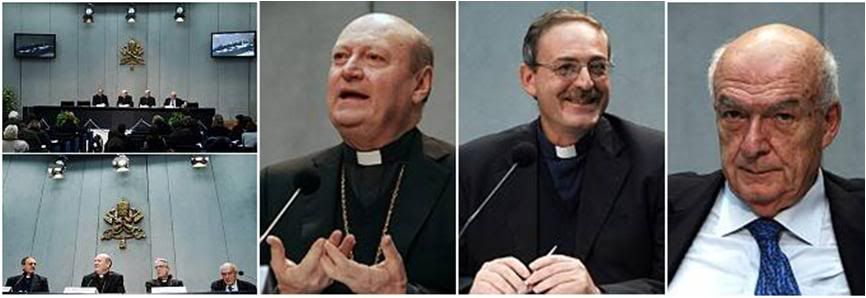 Individual photos, from left: Mons. Ravasi, Mons. Iacobone, and Director Paolucci.
Individual photos, from left: Mons. Ravasi, Mons. Iacobone, and Director Paolucci.
The contents and reasons for the initiative, which will take place in teh Sistine Chapel, were presented Thursday morning, Nov. 5, at the Vatican Press Office by Archbishop Gianfranco Ravasi, president of the Pontifical Council for Culture; Prof. Antonio Paolucci, director of the Vatican Museums; and Mons. Pasquale Iacobone, official responsible for the art-and-faith department of the Council for Culture.
In this second news briefing on the event - the first was on Sept. 11 - a list of more than 250 names were released who have said they will be at the event. Some 500 invitations had been sent to artists in five categories - painting and sculpture; architecture; literature and poetry; music and song; cinema, theater, dance and photography.
"They belong to all the arts," Mons. Ravasi said, "and include non-Catholics, although Catholic artists will be substantially represented." He made clear that the invitations do not include any subsidies.
The meeting is intended to revew the friendship and dialog between the Church and artists in the hope of inspiring new occasions to collaborate.
It will be a start, Mons. Ravasi said, "a seed, a moment representing the desire of the Church for a productive dialog with the world of art, that must necessarily develop in stages adn through various modalities, including through national or territorial institutions".
Mons. Ravasi spoke of the evident 'divorce' that occurred in time between the Church - which after promoting the great artistic revolutions in the past, "appears to have settled with commonplaces or even noble artisanship" - and contemporary artists, many of whom are "more attracted to self-referential experimentation and provocative works". Thus, he said, the need to "find a meeting ground for dialog".
Mons. Iacobone described the organizational work for this event.
"Before the summer, we sent out 500 invitations to artists in five continents, who were selected by a committee on the basis of the individual artist's prestige, professional excellence and particular interests. The present list represents those who answered positively. Notwithstanding the short notice, the acceptances have been more than we expected."
The program for the invitees will start on Friday, Nov, 20. when they will be formally welcomed at the Vatican, who will then visit the Vatican Museums' collection of modern and contemporary art which had been started by Paul VI.
Museums director Paolucci said, "The situation faced by Benedict XVI goes back to the middle of the 20th century, to tha great intellectual that Paul VI was, someone who did not hesitate to expose himself personally to seek out a new rapprochement with the world of art."
"On May 7, 1964," Paolucci recalled, "he met with artists of his time at the Sistine Chapel, as Benedict XVI will do on Nov. 21".
Mons Ravasi will deliver opening remarks, followed by a reading of exceprts from John Paul II's letter to artists om April 1999 and then Pope Benedict's address. The Sistine Chapel choir will perform motets by Palestrina.
Afterwards, the guests will attend a reception at which they will each be given a commemorative medallion minted for the occasion.
After the new briefing on the Sistien Chapel event, Mons. Ravasi also answered questions about the European court tuling against the display of the Cross in Italian schoolrooms.
"I hope that this will reconsidered because it concerns one of the great symbols of Western culture," he said, and referred to the Nov. 3 L'Osservatore Romano article in its Nov. 4 issue, citing the Italian novelist Natalia Ginsburg defense of the Cross as a univeral symbol, printed in the Communist newspaper in 1991.
[Modificato da TERESA BENEDETTA 06/11/2009 14:08] |
| |
 06/11/2009 09:49 06/11/2009 09:49 |
|
| | | OFFLINE | | Post: 18.805
Post: 1.453 | Registrato il: 28/08/2005
Registrato il: 20/01/2009 | Administratore | Utente Veteran | |
|

 On the Pope's coming visit
On the Pope's coming visit
to Rome's Jewish quarter
On January 17, 2010, Pope Benedict XVI will visit the Synagogue of Rome, to meet with the Jewish Community for the 21st Day for Reflection and Progress of Dialogue Between Catholics and Jews, and the feast of “Lead Mo'ed.” Both observances coincide on the same day in 2010.
Known among Italian Jews as the Feast of the 'Mo'ed di Piombo', it commemorates a miraculous event of 1793 when the Jews of Rome escaped an attack by Roman anti-Semites thanks to a sudden storm which doused the fires that had been ignited against the gates of the Jewish ghetto.
"Ghetto", a word which has come to mean either an ethnic enclave or zone where poor people are confined, is of Italian origin.
"Burghetto" - "little town" - was the word used to describe the neighborhoods where Jews were confined by law in medieval Italy. In Venice the island once known as Spina Lunga has become known as La Giudecca [the Jewry], which was also given to the Cannaregio area where where Venetian Jews were warlier confined by law and custom. Today, Giudecca is the term generally used for Jewish neighborhoods throughout Italy.
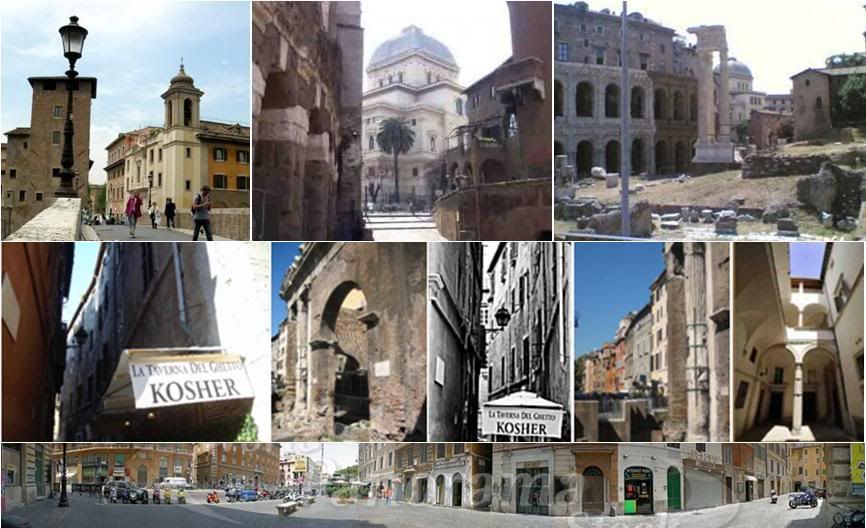 Photos of the Jewish Ghetto in Rome.
In the Italian magazine Panorama this week, a brief item:
Pope will also remember
Photos of the Jewish Ghetto in Rome.
In the Italian magazine Panorama this week, a brief item:
Pope will also remember
Jews deported from Rome
by Ignacio Ingrao

The German Pope will pay homage to Roman Jews who were deported during World War II.
Before going to the Great Synagogue of Rome on January 17, the Pope will make a stop at Largo XVI Ottobre 1943, from where a thousand Jews were sent to Auschwitz.
Unlike John Paul II, whose 1986 visit to the Rome Synaoguge was the first ever by a Pope, Benedict XVI will first walk through the Jewish Ghetto, passing through the Piazza delle Cinque Scole and the Portico d'Ottavia, before proceeding to the Synagogue.
 Left, Portico d'Ottavia; right, Piazza delle Cinque Scole.
Left, Portico d'Ottavia; right, Piazza delle Cinque Scole.
[Modificato da TERESA BENEDETTA 06/11/2009 13:09] |
| |
 06/11/2009 14:06 06/11/2009 14:06 |
|
| | | OFFLINE | | Post: 18.806
Post: 1.454 | Registrato il: 28/08/2005
Registrato il: 20/01/2009 | Administratore | Utente Veteran | |
|
 Friday. Nov. 6
Friday. Nov. 6
 ST. NICHOLAS TAVELIC & COMPANIONS (d Jerusalem 1391)
ST. NICHOLAS TAVELIC & COMPANIONS (d Jerusalem 1391)
Franciscan missionaries and Martyrs
The Croatian saint was beheaded along with Deodat of Rodez,
Petere of Narbonne, and Stephen of Cuneo, after going up to
the Muslim Qadi at the Omar Mosque, and preached the Gospel
to him, then refused to retract their statement. They came
to Jerusalem in 1384 as missionaries for the Franciscan
Custody of the Holy Land, established in 1335. Canonized in
1970, they are among 158 Franciscans martyred there since
that time.
OR today.
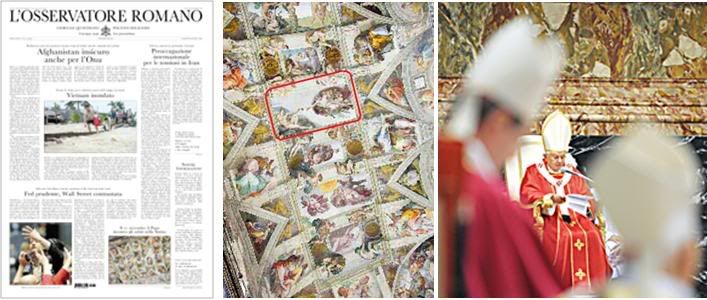 Two papal stories in this issue are referred to on Page 1 - the Mass offered by the Holy Father yesterday for the cardinals
Two papal stories in this issue are referred to on Page 1 - the Mass offered by the Holy Father yesterday for the cardinals
and bishops who died in the past 12 months, and the news briefing on his meeting with some 260 artists at the Sistine Chapel
on Nov. 21. Other Page 1 stories: The UN recalls and relocates some of its offices in Afghanistan as Taliban threats worsen;
new international concerns over Iran which is stepping up its uranium enrichment; critical monsoon flooding in Vietnam; European
central bank follows the US Federal Reserve in keeping interest rates unchanged.
THE POPE'S DAY
The Holy Father met with
- H.E. Nursultan Nazarbayev, President of the Republic of Kazakhstan, with his delegation
- Bishops of Brazil (South Sector I), on ad limina visit
And this afternoon with
- Cardinal William Joseph Levada, Prefect of the Congregation for the Doctrine of the Faith (weekly meeting)
- Cardinal Walter Kasper, President of the Pontifical Council for Promoting Christian Unity.
[Modificato da TERESA BENEDETTA 06/11/2009 14:07] |
| |
 06/11/2009 15:53 06/11/2009 15:53 |
|
| | | OFFLINE | | Post: 18.807
Post: 1.455 | Registrato il: 28/08/2005
Registrato il: 20/01/2009 | Administratore | Utente Veteran | |
|

 Appeal for a more authentic
Appeal for a more authentic
Catholic sacred art
A number of prominent Italian Catholic artists and intellectuals have launched a multi-media campaign soliciting supporters for an appeal they have drawn up addressed to the Holy Father for "a return to authentically Catholic sacred art'.
The initiative comes as a prelude to Pope Benedict XVI's meeting with artists on Nov. 21.
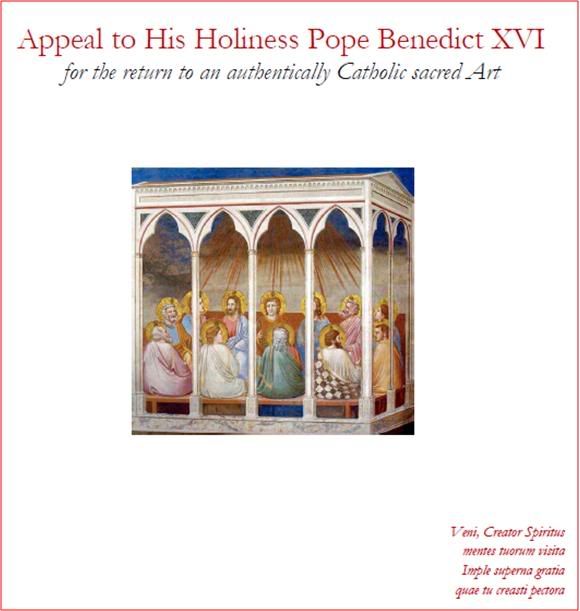
The 15-page appeal may be downloaded on PDF from
www.box.net/shared/506119iz60
It is summarized in a letter that the original signatories have sent to Italian newspapers, translated below:
Dear Editor,
The initiative of an 'appeal' to the Holy Father for a return to an authentically Catholic sacred art comes from a group of theologians, philosophers, artists, architects and intellectuals. Moved by pure spiritual and cultural exigency, they decided to pool together their ideas for a heartfelt appeal to Pope Benedict XVI.
The appeal confronts the actual decadent state of the principal sacred arts, starting with the architectonic structures which should host these arts and favor their development.
Church architecture is not the only aspect but it is the natural vessel containing all the arts intended to promote the liturgy: from painting to sculpture, from mosaics to stained glass, from woodwork to metalwork, to the purest and most evanescent of sacred arts - music.
The conditions today of such arts can be observed completely independent of one's own beliefs and specific tastes. Unfortunately, the problem is in the hands of church sponsors who seem to have renounced their role of promoting Catholic sacred art worthy of the name, but instead relying on current fads and the personal idiosyncrasies of artists and architects.
That is why we are asking the Supreme Pontiff, without in anyway wishing to orient his thinking as inspired by the Holy Spirit, nor even to suggest single-minded ways for renewing Catholic sacred art.
Our intention is to bear witness to the Holy Father of the profound uneasiness felt in common by so many Catholic faithful - both lay and clerical - and lovers of beauty, which in art is the expression of divine Truth.
At the same time, the appeal identifies some fundamental premises for overcoming the present crisis and to correctly innovate sacred art and architecture, so that even in their continuity with modernity, they may be capable of undertaking a new course in full adherence to the bimillenary Magisterium of the Church.
The appeal has been signed initially by members of the promotional committee which includes the following:
- Leonardo Allodi (Professor of the sociology of cultural processes, University of Bologna)
- Paul Badde (Journalist, Die Welt)
- Stefano Borselli (Editor, Il Covile)
- Carlo Fabrizio Carli (Art critic)
- Stefano Chiappalone (Historian)
- Francesco Colafemmina (Classical philologist)
- Giannicola D’Amico (Musicologist and Conservatory professor)
- Pietro De Marco (Professor of the sociology of religions, University of Florence)
- Antonio Donadei (Professor of geometric disciplines in artistic instruction)
- Maria Teresita Ferrari (Painter and hagiographer)
- Giovanni Gandolfo Lambruschini (Editorial director, Maranatha.it)
- Paolo Gandolfo Lambruschini (Editorial director, Maranatha.it)
- Manuel Maria Grillo (Editor, Edizioni Settecolori)
- Steen Heidemann (Architect, art historian, and entrepreneur)
- Anna Maria Kummer (Professor of French)
- Michele Loconsole (Theologian and essayist)
- Ciro Lomonte (Architect)
- Martin Mosebach (Writer)
- Sandro Magister (Vatican correspondent, L’Espresso)
- Enrico Maria Radaelli (Professor of aesthetic philosophy)
- Marco Respinti (Journalist)
- Nikos A. Salingaros (Urbanist, architect adn mathematician)
- Alessandro Sansoni (Historian)
- Guido Santoro (Architect)
- Steven J. Schloeder (Architect)
- Maurizio Serio (Political scientist)
- Ulf Silfverling (Executive editor, Katolsk Observatör)
- Duncan Stroik (University of Notre Dame School of Architecture)
- Cecilia Tagliabue (French scholar)
- Gabriele Tagliaventi (Laboratory of Architectural Design and Building Technology, University of Ferrara)
In addition, we have created a website in four languages (Italian, Spanish, French and English)
www.appelloalpapa.blogspot.com/.
with German and Swedish soon to be added, where interested persons may sign the appeal.
We thank you for the attention that you may wish to give to our initiative.
Cordially in Domino Jesu,
The Promotional Committee
The website, launched on Nov. 4, Feast of St. Carlo Borromeo (seen in the illustration);
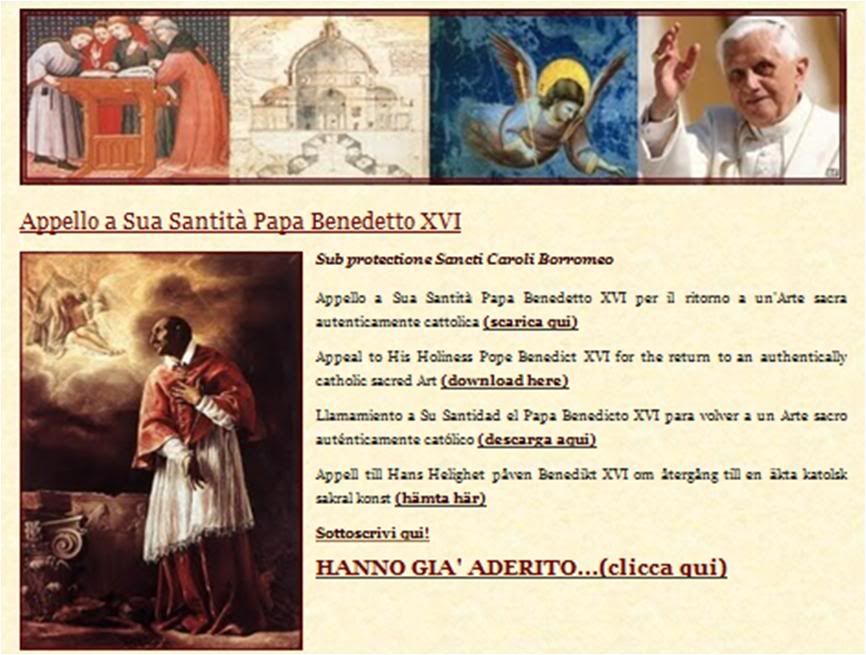
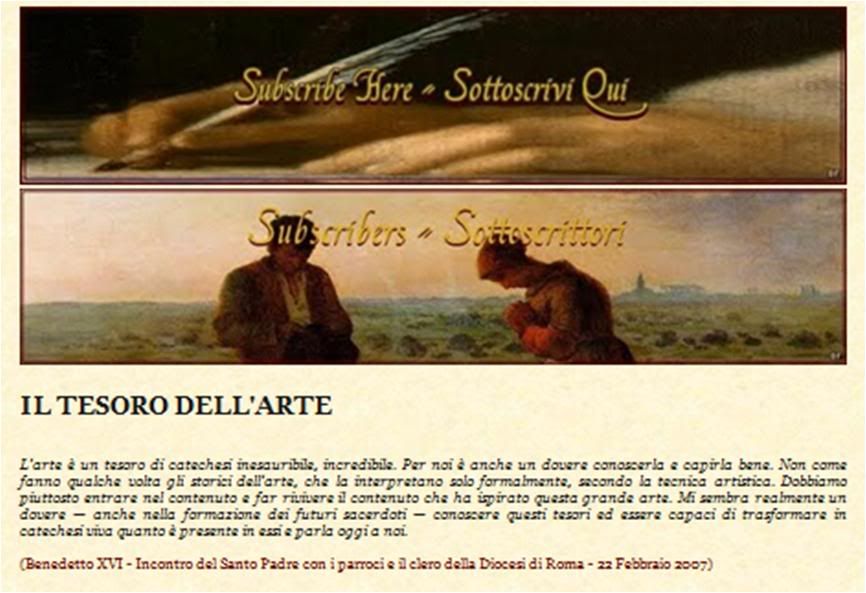 Sandro Magister, who is on the Promotional Committee for the appeal, gives more information on his regular articel on the Church for L'Espresso:
'Most Holy Father,
Sandro Magister, who is on the Promotional Committee for the appeal, gives more information on his regular articel on the Church for L'Espresso:
'Most Holy Father,
in this era of irrational barbarism...'
An appeal to Benedict XVI "for the return to an authentically Catholic sacred art."
The main signatory is the great German writer Martin Mosebach.
Meawhile, the meeting between Nov. 21 the Pope and artists in the Sistine Chapel is drawing near.

ROME, November 5, 2009 – A few days before the meeting announced for November 21 between the Pope and artists in the Sistine Chapel, an appeal anticipating its principal motivation has already come to Benedict XVI's desk.
The appeal is "for the return to an authentically Catholic sacred art," and was signed not by artists, but by scholars and other figures who are passionately concerned, for various reasons, about the fate of Christian art.
Among all: Nikos Salingaros, Steven J. Schloeder, Steen Heidemann, Duncan G. Stroik, Pietro De Marco, Martin Mosebach, Enrico Maria Radaelli.
Mosebach is an established German writer whom Joseph Ratzinger knows well. His latest book: The heresy of formlessness: The Roman liturgy and its enemy" was published this year, including an Italian edition by Cantagalli.
It is a stunning apologia on behalf of great Christian art, and more than that, of the Catholic liturgy itself as art. With biting invective against the iconoclasm that reigns today within the Catholic Church itself.
Radaelli, a disciple of the great Catholic philosopher and philologist Romano Amerio, is a sophisticated scholar of theological aesthetics. His masterpiece Ingresso alla bellezza [Entryway to beauty], released in 2008, is a magnificent introduction into the mystery of God through his Imago, Christ: Beauty as the manifestation of Truth.
The appeal was also born from seminars held in recent months in the library of the Pontifical Commission for the Cultural Heritage of the Church, hosted by its vice-president, Benedictine abbot Michael J. Zielinski.
Participants in the meetings included Fr. Nicola Bux and Fr. Uwe Michael Lang, consultants for the office of papal liturgical celebrations. Fr. Lang is also an official at the Congregation for Divine Worship.
However, no clergyman or Vatican official figures among the promoters of the appeal, whose original signatories are all laymen of various competencies and professions.
After a brief introduction, the test unfolds in seven small chapters dedicated respectively to the causes of the current fracture between the Church and art, theological references, the commission, the artists, sacred space, sacred music, and the liturgy.
It ends with the appeal itself, which is formulated this way:
For all the reasons set out above, we are eager to receive from Your Holiness a fatherly listening and the merciful attention of the Vicar of Christ.
We beseech you, Holy Father, to read in our heartfelt appeal our most pressing concern for the appalling conditions of contemporary sacred art and sacred architecture, as well as a modest and most humble request for your help so that sacred art and architecture can once again be truly Catholic.
This, so that the faithful can again enjoy the sense of wonder and rejoice once again at the presence of the beauty in God's House.
This, so that the Church can be once more regain her rightful place, in this era of irrational, mundane and malforming barbarism, as a true and attentive promoter and custodian of an art that is both new and truly "original": an art that today as always flowers in every age of progress, which reflowers from its ancient roots and eternal origin, faithful to the most intimate sense of Beauty that shines in the Truth of Christ.
[Magister then gives the link to the website and the full text of the appeal].
Reconcilable differences:
The Church reaches out to modern arts
By Carol Glatz

VATICAN CITY, Nov. 6 (CNS) -- Once made in heaven, the marriage between art and the Church has long been on the skids.
"We are a bit like estranged relatives; there has been a divorce," said Archbishop Gianfranco Ravasi, president of the Pontifical Council for Culture.
Much of contemporary art walked away from art's traditional vocation of representing the intangible and the mysterious, as well as pointing the way toward the greater meaning of life and what is good and beautiful, he said during a Vatican press conference Nov. 5.
And the Church has spent the past century "very often contenting itself with imitating models from the past," rarely asking itself whether there were religious "styles that could be an expression of modern times," he added.
In an effort to "renew friendship and dialogue between the church and artists and to spark new opportunities for collaboration," he said, Pope Benedict XVI will be meeting more than 250 artists from around the world Nov. 21 inside one of the world's most stunning artistic treasures: the Sistine Chapel.
The Church's attempts to heal this rift with the world of modern arts span back to Pope Paul VI, who said the troubled relationship between the church and artists was based on misunderstandings and past restrictions on expression that had been removed.
Pope Paul loved art and saw an urgent need to encourage contemporary artists to reclaim their spiritual mission.
He held a landmark meeting with artists in the Sistine Chapel in 1964 and told them they were precious to the Church for their "preaching and rendering accessible and comprehensible -- or better still, moving -- the world of the spirit, of the invisible, of the ineffable, of God."
The Pope set up a collection of paintings, sculptures and graphic art to show how modern culture could still convey religious concepts. He inaugurated the Vatican's Collection of Modern Religious Art in 1973, which contains works by Henri Matisse, Pablo Picasso, Wassily Kandinsky and Edvard Munch.
Pope John Paul II, an accomplished actor, poet and playwright long before becoming a priest, eagerly continued Pope Paul's rapprochement.
He issued a papal letter to artists in 1999 in an effort to "consolidate a more constructive partnership between art and the church."
He sought to exalt artistic endeavors and urged artists and entertainers to steer clear of "empty glory or the craving for cheap popularity" or easy profit.
Artistic gatherings and events have been a common occurrence at the Vatican.
In the decades of Pope John Paul's pontificate, it was not unusual to see all sorts of popular art forms employed. In 2004, for example, Polish break dancers spun on their heads on the marble floors of the Vatican's sumptuous Clementine Hall to the Pope's apparent delight while music blared from a boombox.
Pope John Paul met with countless stars from the entertainment industry, and reminded them of their responsibility to be positive role models, "capable of inspiring trust, optimism and hope."
While Pope Benedict XVI is an avid pianist and has spoken numerous times about the importance of beauty and art, he tends to shy away from raucous encounters.
In fact, then-Cardinal Joseph Ratzinger wrote in 1998 that he had been skeptical of the idea of Pope John Paul sharing the stage in 1997 with a group of rock and pop stars that included Bob Dylan.
"They had a message that was completely different from the one the Pope was committed to," then-Cardinal Ratzinger wrote. He said he wondered whether "it was really right to let these types of 'prophets' intervene."
While it is not clear who made the decision, the Vatican discontinued its annual Christmas concert under Pope Benedict's watch after a 13-year run. [It was a pop concert, nothing more, and did not pretend to be anything but - so I don't know why it is being mentioned here in the same breath as sacred art - or at least, spiritually uplifting art - which is the art that is meant in the context of the Church reaching out to contemporary artists.]
The concert series, which featured well-known international stars each year, had been marred by a controversy in 2003 when the U.S. pop singer Lauryn Hill stunned the audience in 2003 by asking Church leaders to "repent" and speaking of the pain of those abused by priests. It was feared other artists might use their opportunity on a Vatican stage to promote their own personal agendas.
Instead Pope Benedict eagerly attends many of the classical concerts held in his honor.
He will even be featured on a new CD singing and reciting Marian hymns and prayers. The CD, called "Alma Mater," will be released worldwide Nov. 30 by Geffen Records. A similar CD of Pope John Paul reciting the rosary in Latin became an instant hit in 1994.
Pope Benedict has said the Church's ancient treasure of liturgical music should not be frozen in time, but should evolve with appropriate modern-day adaptations.
What is important is that it represents "holiness, true art and universality" and stirs the hearts of its listeners, letting them experience "the same intimacy of the life of God," he told staff and students of the Pontifical Institute of Sacred Music in 2007.
Pope Benedict has said art needs to help people see that authentic truth, beauty and goodness are always intertwined and needs to allow "the beauty of the love of God" to shine through.
The human spirit longs for authentic -- not superficial and fleeting -- beauty that is "in full harmony with the truth and goodness," he has said.
Archbishop Ravasi expanded on that notion at the Nov. 5 press conference when he said art has always had an ethical and transformative role.
He said the world needs artistic expression that lifts people above and beyond "the dust of our own existence and helps us live better."
{And Ms Glatz, one certainly cannot say that of pop concerts, even if they happen to be held at the Vatican!]
[Modificato da TERESA BENEDETTA 07/11/2009 11:56] |
| |
 06/11/2009 17:49 06/11/2009 17:49 |
|
| | | OFFLINE | | Post: 18.808
Post: 1.456 | Registrato il: 28/08/2005
Registrato il: 20/01/2009 | Administratore | Utente Veteran | |
|
 MEETING WITH
MEETING WITH
THE PRESIDENT OF KAZAKHSTAN

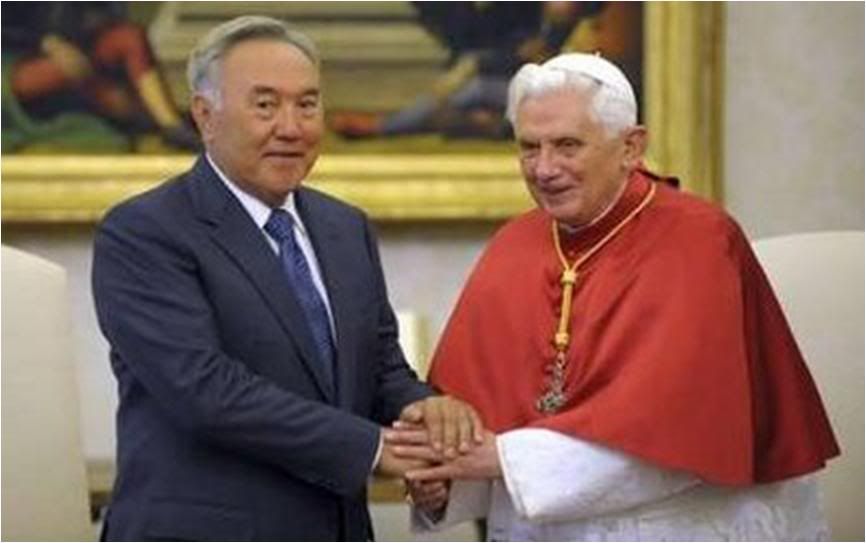
VATICAN CITY, 6 NOV 2009 (VIS) - The Holy See Press Office released the following communique at midday today:
Today, Friday 6 November 2009, His Holiness Benedict XVI received in audience Nursultan Nazarbayev, president of the Republic of Kazakhstan. Mr Nazarbayev subsequently went on to meet Cardinal Secretary of State Tarcisio Bertone S.D.B. and Archbishop Dominique Mamberti, secretary for Relations with States.
During the course of the cordial discussions, attention turned to questions concerning the economic crisis in the light of the Encyclical Caritas in Veritate, to inter-religious dialogue and to the promotion of peace, on the eve of Kazakhstan's presidency of the Organisation for Security and Co- operation in Europe (OSCE).
At a bilateral level consideration was given, with satisfaction, to the good relations that exist between the Holy See and the Republic of Kazakhstan, and to certain themes concerning the current situation of life in the country.
Mention was also made of the peaceful coexistence between faithful of various religions, and the hope expressed that believers may have an ever more active role in the life of the nation and in favour of the common good.
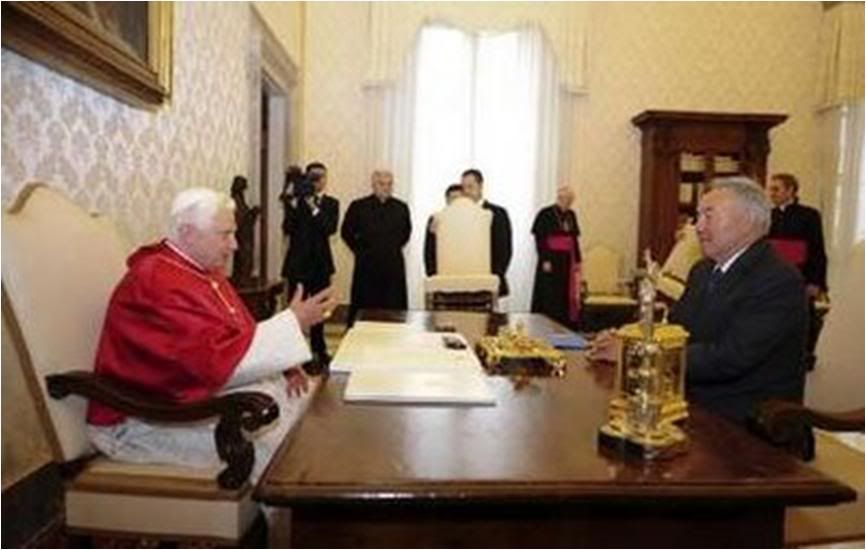

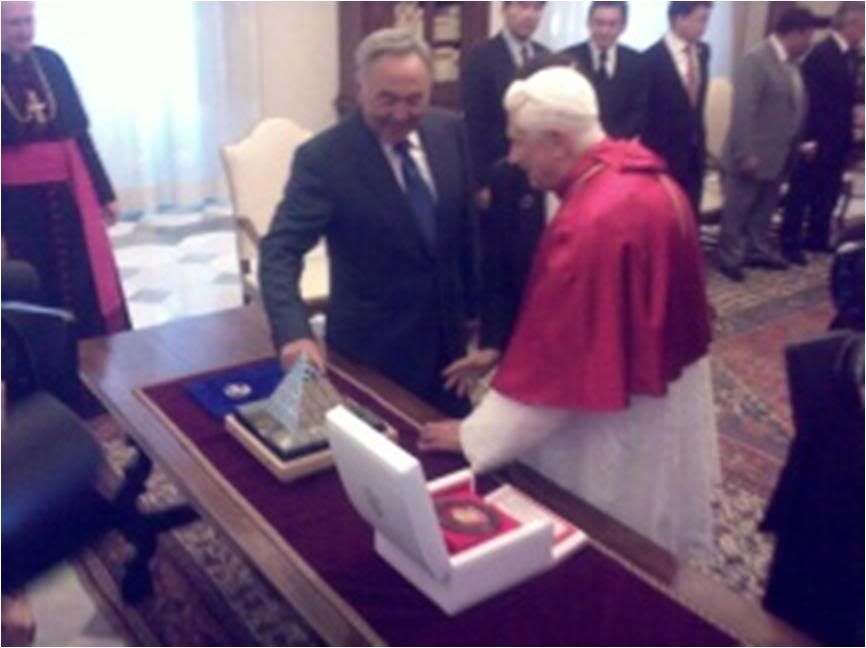 Like Andrea Tornielli, Sandro Magister and Paolo Rodari before her, Angela Ambrogetti, on her fairly new blog, is able to report news in addition to her own commentary when she cannot do so in the regular newspages of the publication she writes for. Very often, the blog items by the Vaticanistas show journalistic enterprise, as in Ambrogetti's report on the Holy Father's audience for the President of Kazakhastan today.
Like Andrea Tornielli, Sandro Magister and Paolo Rodari before her, Angela Ambrogetti, on her fairly new blog, is able to report news in addition to her own commentary when she cannot do so in the regular newspages of the publication she writes for. Very often, the blog items by the Vaticanistas show journalistic enterprise, as in Ambrogetti's report on the Holy Father's audience for the President of Kazakhastan today.
I think, in this case, she was one of the pool reporters, but why don't other pool reporters do the same thing regularly, instead of leaving us with only the SOP-orific, mind-deadening formulations of the official Vatican communiques?
Benedict XVI's 'theological diplomacy'
by Angela Ambrogetti
Translated from her blog

Nov. 6, 2009
"Thank you for having organized John Paul II's visit to Kazakhstan and for your commitment to religious freedom," Benedict XVI told President Nursultan Nuzarbayev of Kazakhstan today.
Indeed, just a few days after September 11, 2001, Nuzarbayev had hosted the late Pope in Astana in a trip that had near-epic dimension. And he continues to be President of a nation that produly hoists tehstandard of secularity.
Kazakhstan was one of the autonomous republics of the Soviet Union, which had a fairly soft transition to independence thanks to Nuzarbayev himself, who had led it under Communism, and ably led it as an independent nation while exercising intelligent management of the country's rich mineral resources.
With more than a hundred tribes with their own traditions, a majority of them non-observant Sunni Muslims, Kazakhstan has some Christians, but less than 1 percent of the population is Catholic. In addition to the official language Kazakh, spoken mostly in the south of the country, Polish, Russian and Ukrainian are also spoken.
Nuzarbayev spoke to Benedict XVI in Russian, with two interpreters on hand. He came out obviously pleased with the audience. The Pope sent him off with a blessing, for which the self-declared atheist thanked him enthusiastically.
The Vatican communique devoted a few lines to what they talked about. [See full text posted above.]
Perhaps to underline how much his government counts on the secular coexistence of faiths, religions and customs in his country, the Kazakh President presented the Pope with a reproduction in silver and enamel of Astana's Palce of Peace and Consensus - a mega-pyramid on a hilltop near the presidential palace, "which looks up towards Paradise", he told the Pope. To which Benedict replied, "Yes, it is a place for concord".
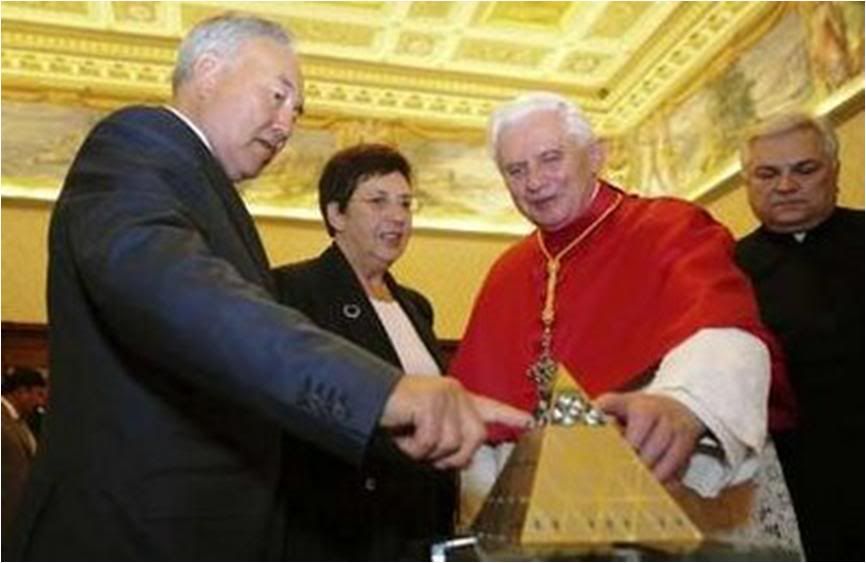
It is, in fact, an imposing achievement of engineering which serves as a conference center for cultural and inter-religious events. Completed in 2006, it hosted the first Congress of World Religions back in 2003, with the participation of a Vatican delegation led by Cardinal Josef Tomko who brought a message from John Paul II.
The late Pope called the Congress a new initiative that echoes the 'spirit of Assisi' and would contribute to promote "respect for human dignity, the defense of religious freedom, and the growth of reciprocal understanding among peoples".
The latest edition of the Congress took place last July at which Cardinal Jean Louis Tauran, President of the Pontical Council for Inter-Religious Dialog, led the Vatican delegation.
Benedict XVI has a series of diplomatic encounters on his schedule this month. On Thursday, Nov. 12, he will receive the President of Croatia; on Nov. 13, the Prime Minister of Hungary; and on Nov. 14, the President of Serbia and the Prime Minister of the Czech Republic. On November 28, Presidents Michelle Bachelet of Chile and Cristina Fernandez of Argentina will visit to mark the 25th anniversary of their nations' agreement over the Beagle Channel, in which the Vatican played an intermediary role.
Also coming to visit before year's end is the Emir of Kuwait, but the date has not been settled.
[Modificato da TERESA BENEDETTA 06/11/2009 23:55] |
| |
 07/11/2009 12:45 07/11/2009 12:45 |
|
| | | OFFLINE | | Post: 18.811
Post: 1.459 | Registrato il: 28/08/2005
Registrato il: 20/01/2009 | Administratore | Utente Veteran | |
|
 John Allen's column this week raises many hackles on my part, as many of his assertions increasingly do!
Benedict's ongoing battle
John Allen's column this week raises many hackles on my part, as many of his assertions increasingly do!
Benedict's ongoing battle
against secularism

Nov. 06, 2009
Much has been made lately of Pope Benedict XVI's apparent lenience for "cafeteria Catholicism" on the right.
[First off, I don't believe I have ever seen anyone else describe the Lefebvrians and the Anglo-Catholics as 'cafeteria Catholics' - since they are, in fact, far more observant of precisely those Catholic traditions, especially in liturgy, and practices (priestly celibacy, no women priests, no same-sex marriage, no abortion, contraception or euthanasia - most of the issues for which that the true 'cafeteria Catholics' of the left have waged ferocious battle) than 'average' Catholics.
And second, the use of the term 'lenience' to describe the Pope's opening to these conservative groups is simply wrong, and unacceptable journalistic license.]
Two developments have fed the perception: talks between the Vatican and the Society of St. Pius X, the "Lefebvrites," who broke with Rome in protest of liberalizing currents after the Second Vatican Council (1962-65); and new structures to allow Anglicans to become Catholic while preserving their heritage, with the most likely takers being conservative Anglicans opposed to homosexuality and women's ordination.
Though it's not clear how many Lefebvrites or Anglicans will walk through the doors Rome has tried to open, the effect on both fronts will be to inject new pockets of traditionalist believers into the Catholic circulatory system. [And what is wrong with that? Allen describes 'traditionalist believers' as though they were a treacherous blood infection!]
What's the underlying logic for such moves? While it may at first blush seem unrelated, a controversial decision on Tuesday by the European Court of Human Rights, which held that displaying crucifixes in Italian public school classrooms violates freedom of conscience, can help provide some context.
In effect, Benedict's outreach to Lefebvrites and dissident Anglicans forms part of a trend I've described as "evangelical Catholicism." One cornerstone is to reassert markers of Catholic distinctiveness -- such as Mass in Latin, and traditional moral teaching -- as a means of ensuring that the church is not assimilated to secularism. At the policy-setting level of the church today, this defense of Catholic identity is job number one.
Historically, "evangelical Catholicism" is a creative impulse rather than something purely defensive, with roots in the papacy of Leo XIII in the late 19th century and his effort to bring a renewed Catholic tradition to bear on social and political life. Nevertheless, fear that secularism may erode the faith from within is also a powerful current propelling evangelical Catholicism forward.
To over-simplify a bit, Benedict XVI is opening the door to the Lefebvrites and to traditionalist Anglicans in part because whatever else they may be, they are among the Christians least prone to end up, in the memorable phrase of Jacques Maritain, "kneeling before the world," meaning sold out to secularism.
At this stage, some critics may be tempted to ask if the cure is perhaps worse than the disease -- in other words, if secularism is really so bad.
Benedict XVI himself has talked about a "healthy secularism," [Excuse me, the Pope speaks of 'healthy secularity', not 'secularism! There is a great difference between secularity practised healthily, i.e., not rabidly as secularists do; and 'secularism' which is the ideology brandished aggressively by the secularists] which involves the separation of church and state and recognition of the essentially lay character of politics.
Evangelical Catholics such as the late Cardinal Jean-Marie Lustiger of Paris actually see this kind of secularism [secularity!] as a precondition for authentic faith, because it forces Christianity to be a personal choice, rather than something imbibed from religiously homogenous cultures where faith and practice are buttressed by the state.
"We're really at the dawn of Christianity," Lustiger used to say of the transition to a secular world.
Yet that's not the perception of secularism that tends to drive the ecclesiastical train these days, especially in Europe. At senior levels of the church, there's a growing conviction that a tipping point has been reached -- that Western secularization is crossing the line from neutrality to outright hostility, toward religion in general and Catholicism in particular.
Cardinal Renato Martino, the former President of the Pontifical Council for Justice and Peace, put things this way: "It looks like a new Inquisition. It is a lay Inquisition, but it is so nasty. You can freely insult and attack Catholics, and nobody will say anything."
All of which brings us back to the stunner this week from the European Court of Human Rights.
The court, based in Strasbourg, issued its ruling in response to a petition from an Italian woman named Soile Lautsi, who lives near Padua and who claimed that having crucifixes in the public school classrooms attended by her two children violates the church/state separation provisions of the European Convention on Human Rights. The court agreed, awarding Lautsi 5,000 euros (roughly $7,400) in damages.
The court did not order Italian schools to remove the crucifixes, in part because under European law it had no authority to do so. Lautsi had tried and failed to press the issue in Italian courts, which rejected her claim on the basis that crucifixes are symbols of Italy's national identity.
The Vatican was predictably dismayed. Jesuit Fr. Federico Lombardi, the Vatican spokesperson, issued a statement greeting the ruling with "astonishment and sorrow." Lombardi decried the effort to "cast out of the educational world a fundamental sign of the importance of religious values in Italian history and culture."
It's tough not to regard the ruling as a way for European judges to grind an axe, since whatever else it may mean, it certainly does not augur the end of crucifixes in Italian classrooms.
Italian authorities have said they will appeal, and politicians of the left, right and center tripped over one another denouncing the ruling. Polls have consistently showed overwhelming public support for leaving the crucifixes in place.
"No one, and certainly not an ideological European court, will succeed in erasing our identity," said Italian Education Minister Mariastella Gelmini, a member of Prime Minister Silvio Berlusconi's center-right coalition.
Perhaps the lone indisputable result of Tuesday's ruling, therefore, is that it will cement impressions [Those were cemented long before this - the omission of any reference to the Christian roots of Europe from the European Union Constitution having been the most egregious instance!] among many religious believers, and particularly among Catholics, that Europe's secular elites are determined to drive religion out of public life -- that the "nasty lay inquisition" to which Martino referred continues apace.
In that cultural milieu, one in which Catholic identity is perceived to be under assault ["Perceived to be'???? It is, all the time, and in many ways! I don't understand Allen's evident hedging, this reluctance to call out things as they are!] -- and, given Tuesday's decision, it's hard to fault Church leaders for drawing that conclusion -- it's no surprise that defense of Catholic identity has become an idée fixe. ['Has become an idee fize'? It hasn't just suddenly 'become' an obsession, which is what idee fize is. Defense of Catholic identity is inherent and implicit in the Catholic faith - not an ad hoc phenomenon - and the Church, particularly the Pope, has the perennial continuing duty to do that!]
That includes efforts to welcome groups into the church who are ferociously committed to important markers of identity, such as traditional forms of liturgy and devotion and traditional moral teachings.
One may, of course, dispute the wisdom of Benedict's open-door policy for the Lefebvrites or disgruntled Anglicans. Yet to pretend that such moves are inexplicable apart from the personal predilections of a conservative Pope is to ignore the social reality of contemporary Europe.
It's not paranoia, in other words, if they really are out to get you.
* * *
I was in Spain this week, speaking at an international symposium organized by the Capuchins on the subject of "What Does Europe Believe In?" with the subtitle, "The Capuchins between Secularization and the Return of Religious Life."
(Regular readers know of my "preferential option" for the Capuchins, the order that educated and formed me all the way through high school and beyond. I went to Madrid largely to pay off that old debt -- though as I said, whether my connection with the Capuchins is to their credit, or their eternal shame, is a matter for others to judge!)
One point I tried to make is that while secularism is a real and present danger, there's an equal-and-opposite risk of becoming so bewitched by secularism that we misdiagnose reality*. [I have posted my comment to this, and Allen's subsequent arguments below, after the article.] Especially in light of this week's ruling from the European Court of Human Rights, it may be worth reproducing here the relevant section from my lecture on Wednesday evening:
"Seen exclusively through a European prism, it could perhaps seem as if secularism is the chief, if not the only, pastoral and cultural challenge facing the faith. The truth, however, is that Europe is really the only zone of the world where secularism has an especially large sociological footprint. In the United States, there are influential pockets of secularism among our cultural elites -- in the faculty lounges of our universities, for example, and on our newspaper editorial boards -- but at the grassroots we remain an intensely religious society. Outside the West, one has to look long and hard to find real secularists."
"In most of the rest of the world, the primary pastoral challenge facing Catholicism isn't secularism but the competitive dynamics of a bustling religious marketplace. In Africa, Asia and Latin America, the main competitors to Catholicism are Christian Pentecostalism, or Islam, or revived forms of indigenous religion. As a result, to craft future strategies for Catholicism based largely on defending ourselves against secularization risks misreading the social situation. Most people in the world, most of the time, aren't seriously tempted by secular agnosticism, but rather by one or another option on the contemporary spiritual smorgasbord -- and that smorgasbord is, therefore, where at least some share of your energy and imagination ought to be directed, not just pondering secularism."
"Let me offer one practical implication. To the extent we define secularism as our main problem, Catholicism inevitably ends up looking defensive, forever building walls around a tradition we believe to be under assault. When the term of comparison is no longer secularism, however, but rather some forms of Pentecostalism or Islam, or quasi-magical currents in indigenous belief, that change of context positions Catholicism differently, as an alternative to religious movements that at times veer toward fundamentalism, extremism, or thaumaturgy. The capacity of Catholicism to integrate reason and faith, to uphold tradition while at the same time engaging modernity, emerges with greater clarity."
"In other words, given what's actually on offer in today's religious marketplace, Catholicism often seems a balanced, moderate, and sophisticated option. For the record, this is how most people on the planet right now actually see the Catholic church, in light of what else they see around them."
"That realization ought to have consequences not only for our missionary and pastoral strategies, but also for our own attitudes about the church."
* I disagree. Secularism and secularization continue to be the greatest danger to the faith because they imply the rejection of God, to begin with, and relegating religion to the purely private and individual sphere of action.
The other forms of religion - pentecostalism, Islam, whatever - are to be fought only if they distort and misuse faith, as fundamentalist Muslims do in using religion and Allah to justify their violence, hatred and irrationality, and as some newer evangelical sects do by over-simplifying faith, and in the wrong way, to equate it with touchy-feeliness, shortcuts to prosperity, or fake wonder-working.
To defend the Catholic faith against secularization is, of course, defensive. But that is not the only aspect of pastoral work and of personal apostolate.
The other side of the coin is evangelization, which is always necessarily proactive - you go out and, by word and the witness of your own deeds, convince non-believers that Christ is the answer and that the Catholic Church is the one, holy, catholic and apostolic Church.
It's a futile exercise to distinguish whether what one says and does is pro-active or defensive - i.e., evangelization of apologetics. What matters is to be a consistent and coherent witness to Christ in word and deed, because that is the best way to both evangelize and stand up for the faith.
[Modificato da TERESA BENEDETTA 07/11/2009 12:51] |
| |
 07/11/2009 13:41 07/11/2009 13:41 |
|
| | | OFFLINE | | Post: 18.812
Post: 1.460 | Registrato il: 28/08/2005
Registrato il: 20/01/2009 | Administratore | Utente Veteran | |
|
 Saturday, Nov. 7
Saturday, Nov. 7
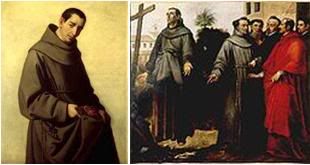 Paintings: Left, San Diego, Zurbaran, 1640; right, San Diego in Ecstasy, Murillo, 1645.
ST. DIEGO DE ALCALA (Spain, 1400-1463) [Latinized name: Didacus]
Paintings: Left, San Diego, Zurbaran, 1640; right, San Diego in Ecstasy, Murillo, 1645.
ST. DIEGO DE ALCALA (Spain, 1400-1463) [Latinized name: Didacus]
Franciscan Brother
The California mission which became the city of San Diego is named
for this Franciscan who performed healing miracles while he worked
as an infirmarian at the convent of Ara Caeli in Rome, where he
attended the canonization of St. Bernardine of Siena. he spent the
rest of his life as a contemplative in Alcala de Henares, dying in
the odor of sanctity. His body also remained incorrupt.
OR today.
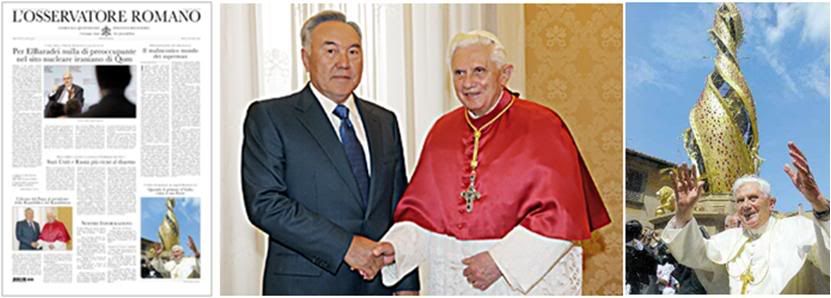 Papal stories in this issue: The Holy Father's audience with the President of Kazakhstan; and a new book on Benedict XVI's pastoral visits in Italy so far. Page 1 stories: The IAEA asks Iran to explain nuclear-arms-related tests, as IAEA head Mohamed El-Baradei concludes there is nothing to be concerned about the nuclear facility in Qom that the Iranians only disclosed recently; another optimistic headline that 'the US and Russia are closer to disarmament'; and an editorial commentary on current developments in biotechnology that favor human designing of 'supermen'.
THE POPE'S DAY
Papal stories in this issue: The Holy Father's audience with the President of Kazakhstan; and a new book on Benedict XVI's pastoral visits in Italy so far. Page 1 stories: The IAEA asks Iran to explain nuclear-arms-related tests, as IAEA head Mohamed El-Baradei concludes there is nothing to be concerned about the nuclear facility in Qom that the Iranians only disclosed recently; another optimistic headline that 'the US and Russia are closer to disarmament'; and an editorial commentary on current developments in biotechnology that favor human designing of 'supermen'.
THE POPE'S DAY
The Holy Father met today with
- Bishops of Brazil (South Sector-I, Group 2) on ad limina visit.
The Vatican released the Pope's message to the Pontifical Council for the Laity and participants in
a Nov. 6-7 seminar in Rome on "Sports, education, faith: Towards a new season in the Catholic sports movement".
Tomorrow, the Pope visits Brescia and Concesio in northern Italy.
[Modificato da TERESA BENEDETTA 07/11/2009 13:44] |
| |
 07/11/2009 14:14 07/11/2009 14:14 |
|
| | | OFFLINE | | Post: 18.813
Post: 1.461 | Registrato il: 28/08/2005
Registrato il: 20/01/2009 | Administratore | Utente Veteran | |
|

 Catholic, Anglican, and civic leaders
Catholic, Anglican, and civic leaders
urge Pope Benedict to visit Durham
when he comes to the UK

Nov. 6, 2009
DURHAM, UK - An invitation has been made to the Vatican which could lead to the first papal visit to Durham.
A consortium of university and religious leaders hope Pope Benedict XVI will accept their invitation to deliver an address in the city. The partnership behind the offer includes both North-East Anglican and Roman Catholic church leaders, but it is backed by other regional political and civic figures.
Pope Benedict, who became the eighth German Pontiff in April 2005, is invited to present an academic address in Durham Cathedral during his scheduled visit to Britain, next September.
Ironically, the cathedral was home to a Roman Catholic order of Benedictine monks until the dissolution of the monastery by King Henry VIII during the Reformation, on December 31, 1540.
The invitation follows a visit by Vatican representative and Her Majesty’s Ambassador to the Holy See, His Exellency Francis Campbell, to Durham University in March.
Although Benedict’s predecessor Pope John Paul II made a pastoral visit to Britain, which included an appearance at York, in May 1982, should the invitation be accepted it would be the first papal visit to the North-East, a region considered as a cradle for Christianity.
The strong ecumenical nature of the invitation is considered a significant step at a time of increased sensitivity in Anglican-Roman Catholic relations.
Leading the invitation is the Rt Rev Dr Tom Wright, Anglican Bishop of Durham and the university’s senior representative, but it is counter-signed and fully supported by the Rt Rev Seamus Cunningham, Roman Catholic Bishop of Hexham and Newcastle, as well as the Durham Cathedral chapter, the Abbot of Ampleforth Abbey and the president of the Roman Catholic seminary for the North, Ushaw College, near Durham.
[Modificato da TERESA BENEDETTA 07/11/2009 14:15] |
| |
 07/11/2009 17:12 07/11/2009 17:12 |
|
| | | OFFLINE | | Post: 18.814
Post: 1.462 | Registrato il: 28/08/2005
Registrato il: 20/01/2009 | Administratore | Utente Veteran | |
|


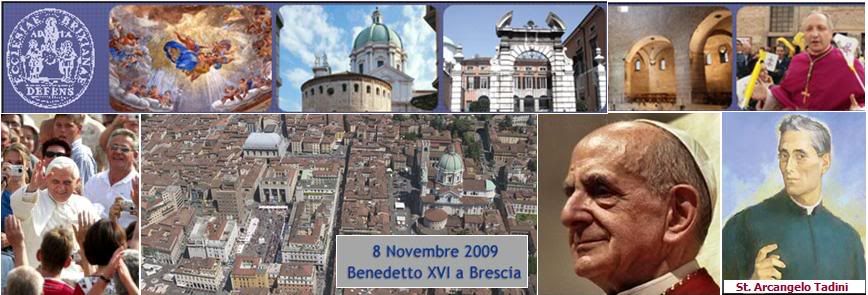 The ties that bind
The ties that bind
Benedict XVI and Paul VI
by Lucio Brunelli
Translated from

November 6, 2009
The homage that Benedict XVI will render tomorrow to Paul VI in Brescia and Concesio is not just a formal act, nor one of institutional duty.
The ideal bonds that unite these two Popes are numerous, and it is not reckless to say that the consonance between Papa Ratzinger and Papa Montini is even more immediate and profound than those between John Paul II and his prefect for the Doctrine of the Faith.

Benedict XVI was one of the last Montiniani cardinals, receiving the red biretta from Paul VI in the last consistory of his Pontificate in June 1977.
Subsequently, Joseph Ratzinger and the American Cardinal William Baum were the last of the Montiniani cardinals to take part in a Conclave. In future Conclaves, for purely chronological reasons, there will be no more Montini cardinals.
But the ties that link the Bavarian Pope to the Brescian Pope are not simply generational. So many other things do. To begin with, their temperament.
Seriousness and a dry reticence: neither one fond of the limelight, almost timid. Discretion and delicacy: As natural virtues, bred into their DNA. Virtues that are rare and precious in our day, which is marked by coarseness, the obligation to blabber and scream while unable to listen to others, nor to have patience with them.
Ratzinger and Montini - two refined intellectuals who decided to devote themselves to the care of souls. The first, a theologian and university professor, whose reputation reached Rome early. The second, spiritual director to the Italian Catholic university federation, and a lifelong lover of philosophy and the arts. Both of them passionate devotees of the Fathers of the Church, especially St. Augustine.
Both have used their rediscovery of Tradition to approach modernity in a new way. The great challenge: to heal the split between faith and reason, or even, between faith and life.
Neither of them, as young priests, had the pastoral experience of being a simple parish priest. [Though Joseph Ratzinger spent at least a year after ordination carrying out the full range of pastoral duties in a suburban, partially rural parish.]
Ratzinger almost immediately proceeded to further studies and teaching, while Montini was recruited into the diplomatic service of the Holy See.
And then, as mature Churchmen, both were suddenly and unexpectedly catapulted to lead important dioceses: Munich and Milan, respectively, before ending up Bishop of Rome, the Church born with the blood of the Apostle Martyrs Peter and Paul.
So many human and existential traits in common. A perfect consonance in their historical judgment of Vatican II and the troubled execution of what it decreed.
The young Ratzinger was one of the theologians of renewal. The great Council called by Blessed John XXIII seemed destined to realize all the dreams and expectations of a 'new' Church that was to be, finally, much closer to contemporary men, liberated from useless frills, open to ecumenical dialog, a Church of mercy and witness rather than one of condemnation and naysaying. All ideals shared by the theologian and the onetime university counselor.
But them came the initial disappointments, immediately following the conclusion of Vatican II. In the early 1970s, these already included liturgical abuses, questioning the fundamental truths expressed in the Creed, crisis of vocations, rejection of papal authority...
Paul VI felt that many hopes had been betrayed: "It was thought that after the Council, there would be a time of sunlight for the Church. Instead, there have been clouds, storms and darkness... Through some crack, the smoke of Satan has entered the Temple of God" (June 29, 1972).
Those were the same thoughts that permeated the reflections of Professor Ratzinger in the post-Conciliar years - which had nothing to do with the general anti-Conciliar attitude of the Lefebvrians. Rather, it was in defense of the true Vatican II against the widespread interpretation that presented it as a rupture with
Tradition.
This assonance in judgment and concerns would prompt Paul VI to name Prof. Ratzinger Archbishop of Munich-Freising on March 24, 1977, and a few months later, cardinal, on June 27, 1977.
In his homily at the Consistory Mass, Paul VI made a heartfelt appeal for reconciliation and unity within the Church, even as he used harsh words to condemn both traditionalist defiance and progressivist disorientation.
"To those who, in the name of falsely understood creative freedom, have brought such damage to the Church by their improvisations, banality and triviality - indeed, even with deplorable profanation - we ask them to abide strictly by established norms. If these are not respected, then the essence of Catholic doctrine itself, not to mention ecclesiastical discipline, are at risk".
In presenting the new cardinals of that mini-consistory [the others were Bernardin Gantin of Benin, the Italians Mario Ciappi (then theologian of the papal household; and Giovanni Benelli (for 10 years, he ran the Secretariat of State for Paul VI, named a month earlier to be Archbishop of Florence, and the leading 'moderate' papabile in the two Conclaves of 1978); and Frantisek Tomasek, Archbishop of Prague, named in pectore the year before], the Pope addressed these words to Cardinal Ratzinger:
"We attest this faithfulness to you, Cardinal Ratzinger, whose elevated theological teaching in prestigious university chairs of your native Germany and in numerous worthy publications, has made it clear how theological research - following the royal way of 'fides quarens intellectum' - cannot and should not be detached from profound, free and creative adherence to the Magisterium which authentically interprets and proclaims the Word of God".
For his part, Benedict XVI has paid homage several times as Pope to his great predecessor: "As our lookback towards the past becomes gradually wider and more informed, the merit of Paul VI appears even greater - I would even say superhuman - in presiding over Vatican II, in leading it to a happy end, and in governing the tumultuous post-Conciliar phase" (August 3, 2008)
It would be very reductive to see the link between Popes Ratzinger and Montini in terms of post-Conciliar Catholic 'regret'.
Brescian Cardinal Giovanni Battista Re said rightly, that "more basically and above everything else, what binds them is the profound humanity of their love for Christ and the Church" - both Popes, though intellectuals, passionate witnesses and defenders of the 'faith of the simple folk'.
Addressing the members of the Istituto Paolo VI at the Vatican in March 2007, Papa Ratzinger said:
"The secret of the pastoral activity which Paul VI carried out with tireless dedication - while making some difficult and unpopular decisions [particularly Humanae Vitae] - was his love of Christ - a love that vibrates in moving expressions in all of his teachings.
"His sense of being the Universal Pastor was impelled by a missionary urge nourished by s sincere desire for dialog with all of mankind."
Benedict XVI said that Paul VI's prophetic call, which he made so many times, "to renew a world tormented by violence and unease through 'a civilization of love' was born from his total trust in Jesus, Redeemer of man."
A 2003 interview given to 30 GIORNI by Cardinal Ratzinger has often been cited for his personal reminiscences of John Paul I and the cardinal's participation in the two conclaves of 1978, but the first part of the interview has been much less cited, about his personal reminiscences of Paul VI, which I have excerpted here:
'The Lord chooses our poverty'
Cardinal Ratzinger tells of his nomination as Archbishop of Munich and as cardinal by Paul VI in 1977
and the two conclaves of 1978
by Gianni Cardinale

Vol, 9, 2003
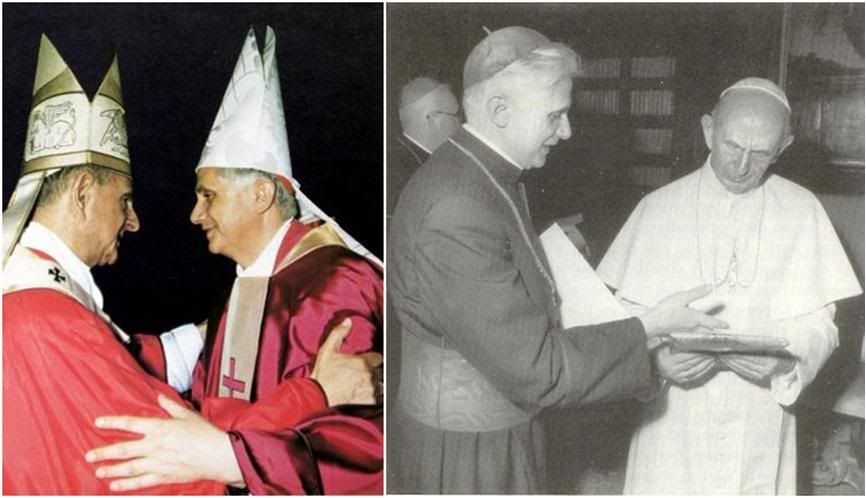 The two photos above exhaust the few photos available online showing Cardinal Ratzinger and Paul VI together.
The two photos above exhaust the few photos available online showing Cardinal Ratzinger and Paul VI together.
...
Your Eminence, on 24 March 1977 Paul VI named you Archbishop of Munich, three months later he created you cardinal…
Two or three days after my episcopal consecration on May 26, I was informed of my nomination as cardinal, which therefore almost coincided with the sacramental ordination. It was a great surprise to me. I still don’t know how to explain it all myself.
I know however that Paul VI was aware of my work as theologian. So much so that some years earlier, perhaps in 1975, he had invited me to preach the spiritual exercises in the Vatican. But I didn’t feel sure enough of my Italian nor of my French to prepare and risk such a venture, and so I said no. But it was evidence that the Pope knew me.
Maybe Monsignor Karl Rauber, now Nuncio in Belgium, played some part in the story. He was then a close collaborator of the Mons. Giovanni Benelli, then Deputy Secretary of Satte (the Sostituto). In any case, it’s a fact, they’ve told me, that in picking out one of the three names recommended to him for the appointment to Munich and Frisinga, the Pope personally chose my poor self.
The consistory of 27 June 1977 was small, with only five new cardinals…
Yes, we were a small group, interesting and pleasant. There was Bernardin Gantin, the only one still alive apart from myself. [Gantin died in 2007.] And then Mario Luigi Ciappi, the theologian of the Pontifical House, Benelli of course, and Frantisek Tomasek who had been chosen in pectore already the year before and who received the purple along with us.
They say it was Benelli, who had been appointed Archbishop of Florence on 3 June, who “chose” the names for that “mini-consistory”…
Could be. I’ve never wanted, and don’t want now to speculate about e these things. I respect Providence; what the instruments of Providence may be doesn’t interest me.
What do you remember of that ceremony?
That at the consigning of the biretta, I had a great advantage over the other new cardinals. None of the others had a large entourage with him. Benelli had worked for a long time in the Curia and was not very well known in Florence, so there weren’t many faithful from that city. Tomasek – there was still the Iron Curtain – couldn’t have followers present. Ciappi was a theologian who had always worked, so to speak, in isolation. Gantin is from Benin and it’s not easy to get from Africa to Rome. Whereas I had a crowd behind me: the hall was almost full of people who had come from Munich and Bavaria....
The applause for me was greater than for the others. You could see Munich was present. And the Pope was visibly pleased to see his choice in some way confirmed.
Were you able to have a personal conversation with the Pope on that occasion?
After the liturgy when the Pope had consigned the ring to us, I was told that he wanted to speak to me in private. I had been for many years a simple professor, very far from the upper reaches of the hierarchy and I didn’t know how to behave, I felt a bit awkward in that context.
I didn’t dare speak to the Pope because I still felt too simple, but he was very good and encouraged me. It was a conversation without specific intentions, he wanted to know me first hand, after maybe Benelli had spoken to him about me.
What do you remember of the last year of the pontificate of Paul VI?
At that time, along with the other bishops of Bavaria, I came to Rome for the ad limina visit. And on that occasion, we had a fine meeting with the Pope. Paul VI began to speak in German, he did it fairly well, but he then decided to pass to Italian in which it was easier to communicate.
He spoke from the heart of his life and of his first visit to our country. He recalled that when he had been in Munich, as a young priest, he was somewhat lost and had found many people who had helped him.
It was a personal conversation, without grand discourses: you could see that his heart was open and he simply wanted to share some moments with some of his brethren in the episcopate. It was a very pleasant encounter.
Did you come to Rome at other times when Paul VI was Pope?
Yes, for his eightieth birthday [26 September 1977]. On October 16, he celebrated a High Mass in St Peter’s. I was impressed on that occasion by the way he quoted the Divine Comedy where Dante speaks about «that Rome whence Christ is Roman» [Purgatory, XXXII, 102, ed.].
Paul VI was considered a bit of an intellectual who had difficulty being warm with others. At that moment he showed an unexpected warmth for Rome itself. I didn’t know or didn’t remember those words of Dante. They impressed me very much.
With those words Paul VI wanted to express his love for Rome that has become the city of the Lord, the center of his Church.
How did you learn of Papa Montini’s death?
I had gone on holiday in Austria. I was informed on the morning of 6 August that the Holy Father had suddenly taken ill. I called the Vicar General of Munich to tell him to immediately ask the whole diocese to pray for the Pope.
Then I took a little excursion and when I returned they phoned me to say that the Pope's condition had gotten worse and shortly after, they called again to tell me he was dead. So I decided that I’d return to Munich the following morning... After writing a letter to the diocese I left for Rome.
Where you attended the Pope’s funeral...
What struck me was the absolute simplicity of the coffin with the Gospel placed on top. The lack of ostentation, the Pope had decided on it, almost shocked me.
I was also impressed by the funeral Mass celebrated by Cardinal Carlo Confalonieri, who being over eighty, would not take part in the conclave: he gave a very fine sermon. As did Cardinal Pericle Felici during another Mass, who spoke of how during the funeral the pages of the Gospel on the Pope’s coffin had been turned by the wind. I then returned to Munich to celebrate a Mass in suffrage: the cathedral was very crowded. Then I came back to Rome for the conclave.
Where you were a “tyro” cardinal…
I was among the youngest but, because I was a diocesan bishop, I belonged to the order of the presbyters, and hence, in the protocol, I came before many Curia cardinals who belonged to the order of deacons. So I was not among the last placed. I remember that at lunch, precedence was also respected and I found myself between Cardinals Silvio Oddi and Felici, two very Italian cardinals....
The English translation of the full interview may be found on
www.30giorni.it/us/articolo_stampa.asp?id=1503
Forgive me for a personal digression here, but I could have 'feasted my eyes' on Joseph Ratzinger in the glory of his Golden Fifties if I had been more aware on the two occasions he was surely present and which I covered - with the help of powerful binoculars and a TV crew located atop the left wing of the Bernini colonnade overlooking the Sagrato. Herewith, my ID tags for the Funeral of Paul VI and for the Inaugural Mass of John Paul II in 1978 (I whited out my surname). For John Paul's Inaugural Mass, the S indicates I was entitled to be in the VIP section on the Sagrato with the Philippine delegation, but I chose to be with my crew, and the delegation did have a private audience with the new Pope two days later. Still, to have missed Cardinal Ratzinger then....:

[Modificato da TERESA BENEDETTA 07/11/2009 19:06] |
| |
 07/11/2009 20:58 07/11/2009 20:58 |
|
| | | OFFLINE | | Post: 18.816
Post: 1.464 | Registrato il: 28/08/2005
Registrato il: 20/01/2009 | Administratore | Utente Veteran | |
|


 Benedict XVI in the land of Montini -
Benedict XVI in the land of Montini -
the Pope who was 'thankful to be Brescian'
by Giselda Adornato
Translated from

Nov. 7, 2009
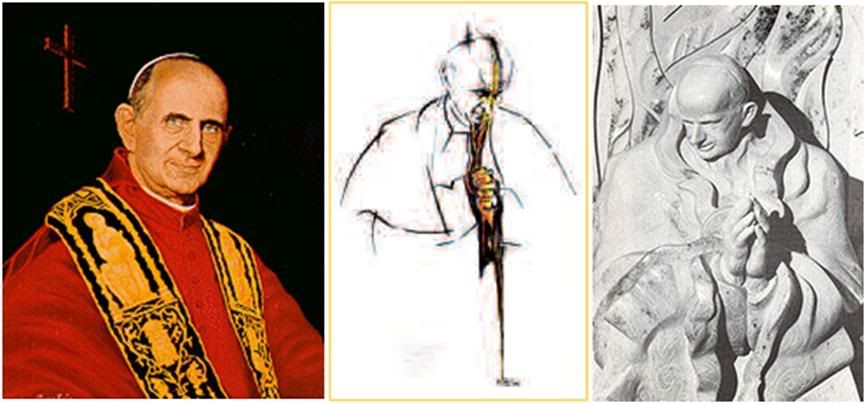 Above, left: 1965 portrait by Morris Katz; center, from a diocesan brochure; right, sculpture in the Cathedral of Milan.
Above, left: 1965 portrait by Morris Katz; center, from a diocesan brochure; right, sculpture in the Cathedral of Milan.
Below, 'the land of Montini' - left, Brescia; right, Concesio.

Tomorrow, Nov, 8, Benedict XVI will make a pastoral visit to Brescia - in the morning, he will celebrate Mass at the Piazza Paolo VI, and in the afternoon, he will go to Concesio, birthplace of teh late Pope, 8 kms from the center of Brescia, where he will inaugurate the new headquarters of the Istituto Paolo VI, an international center for studies and documentation founded one year after the Brescian Pope's death.
The Pope's visit will be very much defined by the memory of his predecessor, so it is worth while to recall the ties that bound Paul VI to this land.
Attachment to the family, to the roots of the Brescian Catholic world, to the teachers of this land, are all fundamental elements for the life experiences of Giovanni Battista Montini.
As Pope, whenever he had occasion to meet with Brecians at the Vatican, he never failed to express his regret at the long years he had been away from his home town. In 12970, he said he felt "like someone asleep for long years who wakes up with everything changed around him, but thinks he is still where he was when he fell asleep. But he is surprised that he does not recognize anyone nor the things around him. He feels a stranger in his own home, and realizes the devouring and regenerative powers of time. Labuntur anni! - The years glide by. I have missed Brescia for more than 50 years, and my memories stop in my youth..."
Giovanni Battista Montini was born in Concesio on Sept. 26, 1897. His father Giorgio (1860-1943) was one of the most important figures in Brescian Catholic action in his time. Having become editor of the newspaper Il cittadino di Brescia when he was only 21, he became one of the founders of the Partito Popolare and a deputy in the regional Parliament.
His mother, Giuditta Alghisi (1874-1943) was also a committed Catholic activist and president of the Catholic Women's league of Brescia.
Battista, as he was always called by his family, was in poor health because of heart problems that he generally overcame, in the country surroundings of the Montini home in Concesio even through his seminary years before the First World War.

The marker on the house in Concesio reads: "In this house was born, on September 26 in the year 1897, Giovanni Battista Montini who was elevated to become Supreme Pontiff with the name Paul VI. He announced to the world a civilization of love which he learned as a boy behind these walls".
Four weeks before he died in 1978, Paul VI wrote his cousin Vittorio Montini: "(I remember) our old Concesio. unforgettable with the dear and pious memories of those most venerated persons who await us in the communion of eternity! Oh, how I have always felt them present, and how I now feel them very near!"
But the center stage in Montini's daily life as a youth was Brescia, since 1907, near the Shrine of the Madonna delle Grazie, where don Battista would later celebrate his first Mass (and is now the seat for the diocesan postulation for the cause of his beatification).
In that church, he received his first Communion under the care of the Sisters of Maria Bambina (young Mary). He was confirmed in the chapel of the Collegio Cesare Arici, then under the Jesuits, where he had his elementary and intermediate education from 1902-1913. He earned his high school certificate from the classical Liceo Arnaldo da Brescia in 1916, entering the diocesan seminary in October, in the midst of the war.
In these Brescian years, a great circle of family, friends, and teachers transmitted to the youth a faith that was free, strong and loyal, as well as a great attachment to the Church adn to the Papacy.
Brescia was experiencing a time of unparalleled fervor in the educational, social and religious commitment of its Catholic community, although its Catholic lay faithful had been among the most organized in Italy since the mid-19th century.
In the center of Catholic life were religious formation and concern for education. There was the Catholic Youth Circle, whose members included Giuseppe Tovini (now a Blessed) and the future Pope's father Giorgio Montini. Spiritual exercises were widespread. The sisters Elisabetta and Maddalena Girelli (whose process of beatification is also under way) refounded the community of St. Angela Marici. Many popular Catholic publications came out aimed at women. Rural cooperatives and the Banca San Paolo founded by Tovini were active in assisting farmers and artisans.
This lively diocese, in Montini's youth, was led by bishops Giacomo Corna Pellegrini (1827-1913) and Giacinto Gaggia (1847-1933), both great promoters of priestly vocations and of committed lay faithful. Mons. Gaggia followed closely the formative itinerary of Montini, setting him an example of doctrine, humanity and spirituality.
Under those two bishops, new Catholic publications and institutions flourished, like the magazine La Madre Cattolica, the weekly Pro Familia, the publishing house Queriniana, the Pious Institute for Poor Artisans, the publishing house La Scuola, which was managed for 50 years by Mons Angelo Iammarchi, who delivered the homily at don Montini's first Mass.
These activities were not hampered in the Fascist years, but although they lost their newspaper and their various Circles, carried on with their mission of 'shaping consciences' through the publishing house Morcelliani, which promoted great contemporary Catholic thinkers like Jacques Maritain and Romano Guardini.
The Montini homes in Brescia and in Concesio functioned as hearths for these Catholic movements, which were undoubtedly very important to the formation of the young Montini.
Especially influential was his assiduous assistance at the Oratorio della Pace, under the religious of St. Philip Neri. All his life, Montini remained particularly close to a Father Bevilacqua who would hide him in his home in Rome during the cusp between the 1920s and 1930s, when Montini was sought by the Fascists, and whom he would make a cardinal; as well as to Fr. Paolo Carosana who became his confessor.
To freqeunt the 'Pace', as the Brescians called the Oratory, meant receiving a proud and committed faith that expressed itself in catechesis and charity. Don Battista became prefect of the local Marian congregation, which was engaged in education and distributing Catholic literature. But he was also part of a local St. incent de Paul association which ran soup kitchens during the wars.
So he had quite a range of experiences in various aspects of teh apostolate. But perhaps the most important was his contributions to the newspaper La Fionda, the organ of a cenacle fo spiritual friendships, of which Don Montini was the moral guide, promoting religion lived as the spring of renewal for society after the tragedy of the Great War. This would be supressed in 1926 under Fascism.
Amogn the palces associated with Montini's youth, one must ment6ion Chiari, a few kilometers from Brescia, where the young Battista met a community of Benedictine monks who left a strong mark on his spirit and influenced him to become a priest.
On May 29, 1920, Mons. Gaggia ordained him a priest in the Cathedral of Brescia. Don Battista thought of his future as a priest caring for souls in a parish.
But the following year, he was sent to Roem to pursue academic studies - and he would not return to Brescia again, except for visits to his family, increasingly brief; or on pastoral occasions when he was Archbishop of Milan.
But his affection remained strong for that world, an affection with a strong streak of nostalgia. In that meetign with Brescians in 1972, he voked "so many worthy persons met in Brescia during the first period of my life - admriable priests, exemplary and most courageous laymen, institutions that worked in a spirit of militant Christianity and charity, an atmosphere of faith and activity permeated by an uncommon spirit of sincere religious piety and virile civic and social sentiments... A healthy and profound religiosity which finds in the Catholic faith the spring and vigor for the characteristic Brescian virtues of directness and goodness".
He concluded: "This Pope is grateful to God and appreciative to all of you for the fact that I am Brescian".
[Modificato da TERESA BENEDETTA 07/11/2009 22:53] |
| |
 07/11/2009 22:37 07/11/2009 22:37 |
|
| | | OFFLINE | | Post: 18.817
Post: 1.465 | Registrato il: 28/08/2005
Registrato il: 20/01/2009 | Administratore | Utente Veteran | |
|


 Before I get caught up in keeping abreast of all the events during the visit tomorrow, I think it is fitting to put across an idea of the admirable organizational and promotional work carried out by the Diocese of Brescia for a visit that really involves two Popes, one of them on course for beatification.
Before I get caught up in keeping abreast of all the events during the visit tomorrow, I think it is fitting to put across an idea of the admirable organizational and promotional work carried out by the Diocese of Brescia for a visit that really involves two Popes, one of them on course for beatification.
Here are some of the materials that the Diocese has available online at
www.diocesi.brescia.it/visitapapabenedetto/index.php
for the faithful and the media who are following the visit.
The initiatives lined up preparatory to the visit, and the program for the visit:
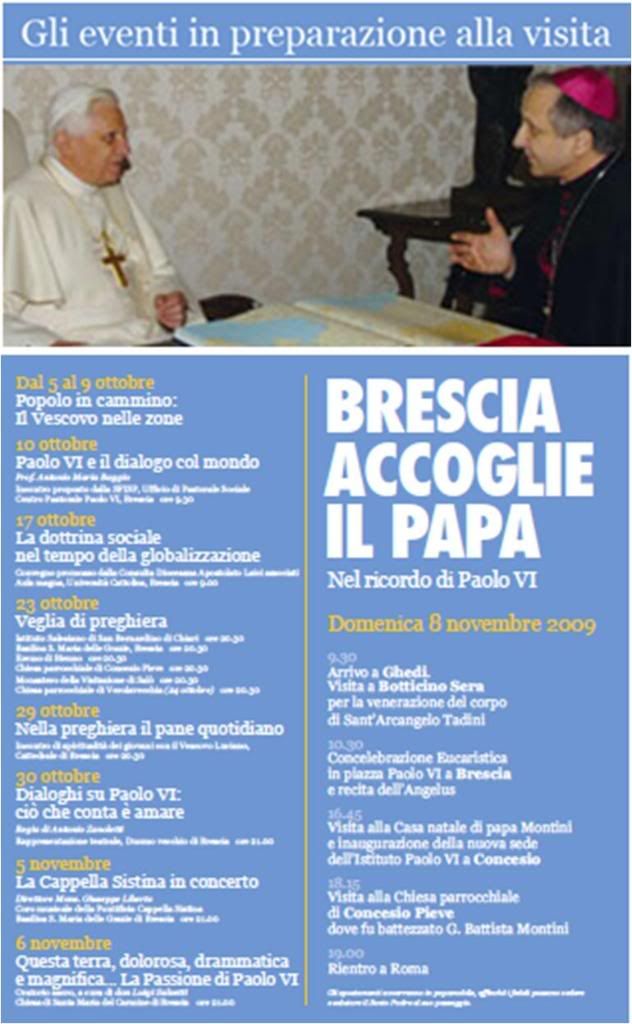 Mons. Monari's diocesan visits to prepare his flock for the Pope's arrival:
Mons. Monari's diocesan visits to prepare his flock for the Pope's arrival:
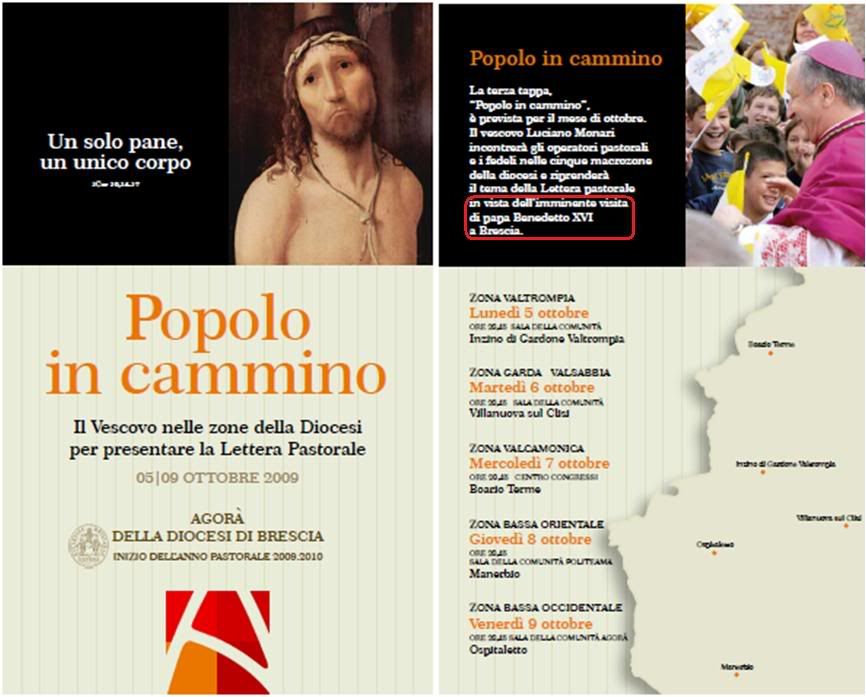 Left, Prayer guide and schedule of Sunday homily models in the month preceding the visit; right, a seminar on Caritas in veritate and globalization.
Left, Prayer guide and schedule of Sunday homily models in the month preceding the visit; right, a seminar on Caritas in veritate and globalization.
 Left, a prayer guide for the Rosary with meditations by Paul VI; right, a pamphlet on the role of the Pope in the universal Church.
Left, a prayer guide for the Rosary with meditations by Paul VI; right, a pamphlet on the role of the Pope in the universal Church.
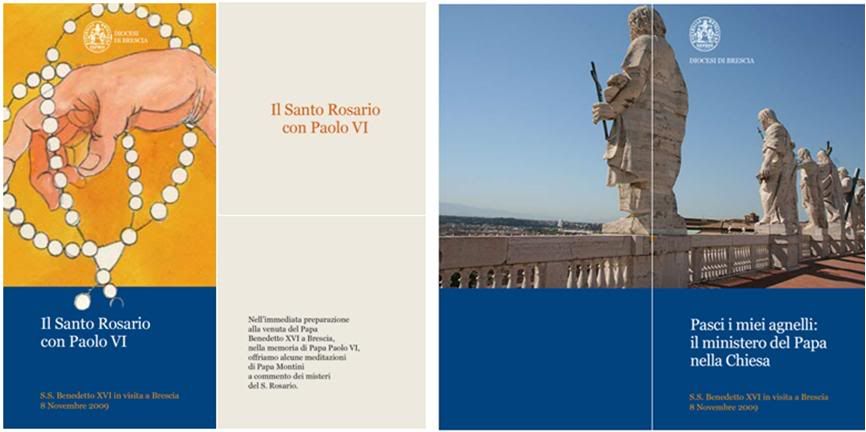 Left, a handout on Paul VI: 'A life to know, a teacher to heed, a witness to imitate'; right, flyer for a theatrical presentation at the Cathedral of Brescia on the life and work of the late Pope: "Dialogues on Paul VI: What matters is love".
Left, a handout on Paul VI: 'A life to know, a teacher to heed, a witness to imitate'; right, flyer for a theatrical presentation at the Cathedral of Brescia on the life and work of the late Pope: "Dialogues on Paul VI: What matters is love".
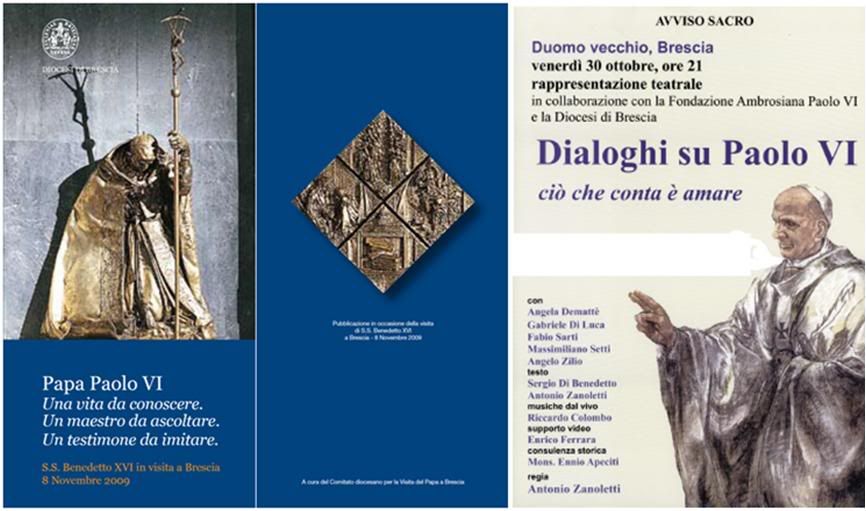 And not to forget, a handout on Concesio, and one on St. Arcangelo Tadini, whom the Pope will venerate in the saint's parish church of Botticino Sera tomorrow morning before proceeding to the city center of Brescia.
And not to forget, a handout on Concesio, and one on St. Arcangelo Tadini, whom the Pope will venerate in the saint's parish church of Botticino Sera tomorrow morning before proceeding to the city center of Brescia.
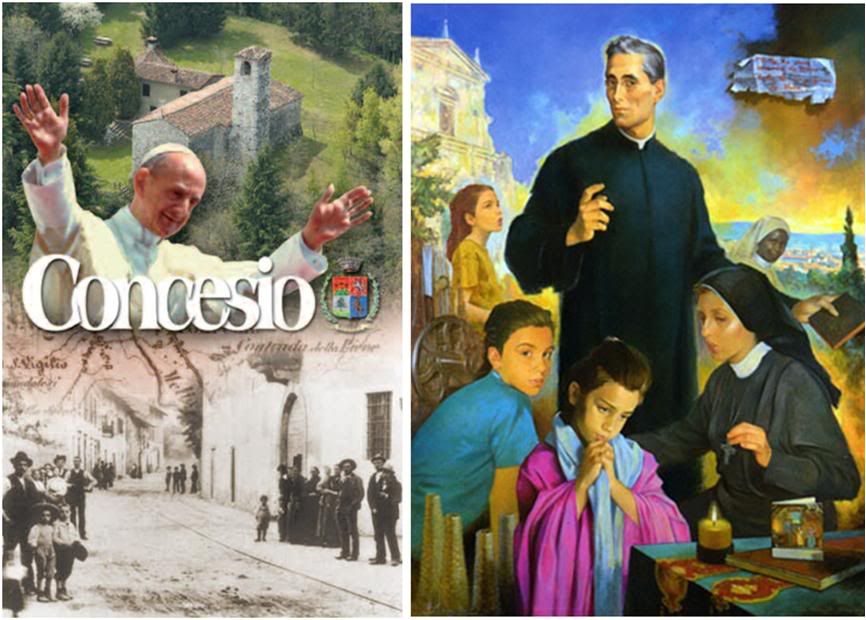
[Modificato da TERESA BENEDETTA 07/11/2009 22:52] |
| |
 07/11/2009 23:15 07/11/2009 23:15 |
|
| | | OFFLINE | | Post: 18.818
Post: 1.466 | Registrato il: 28/08/2005
Registrato il: 20/01/2009 | Administratore | Utente Veteran | |
|
 Pope encourages sports -
Pope encourages sports -
but not doping

VATICAN CITY, Nov. 7 (AFP) – Pope Benedict XVI spoke out against drug-taking in sport on Saturda, in a message to participants of a seminar on sport, education and faith,
The Pope said the Catholic Church believed sport could be a force for good, particularly among young people, but warned against harmful aspects such as doping.
"Sport has great educational potential, especially for the young ... and when it is practised with enthusiasm and a strong ethical aspect it becomes the place for healthy competition and physical improvement, a training ground for spiritual values, a means of personal growth," he said.
The Church should support sport's positive aspects, the Pope said, particularly its capacity to spur young people to courage, competition and tenacity in pursuit of their ambitions.
Yhe Pope stressed the importance of "avoiding the temptation to change the nature of sport by turning to practices which damage the body, such as doping."
[Modificato da TERESA BENEDETTA 07/11/2009 23:16] |
| |
 08/11/2009 00:38 08/11/2009 00:38 |
|
| | | OFFLINE | | Post: 18.819
Post: 1.467 | Registrato il: 28/08/2005
Registrato il: 20/01/2009 | Administratore | Utente Veteran | |
|

 When the Primate of Italy
When the Primate of Italy
visits his country...
Translated from
the 11/7/09 issue of

On the eve of his 17th pastoral visit in Italy, which Benedict XVI carries out tomorrow in Brescia and Concesio, the Vatican publishing house and the Embassy of Italy to the Holy See are publishing a book that documents the 16 preceding pastoral visits.
The book is I viaggi di Benedetto XVI in Italia (182 pp, Euro 38). [LEV has not yet posted anything online about the book!]
The intention, writes Ambassador Antonio Zanardi Landi, is "to render testimony to a shared vision of secularity that is mature and more consolidated with the passage of years, based on the common awareness of the Italian State and the Church of the continuity between authentic human values and Christian ones".
"It is a vision which - from the convergence of political and religious efforts deriving from it, harmonious as much as they are effective - can certainly be taken as a model".
Following is the text prepared for the book's presentation by Gianni Letta, undersecretary to the Italian Council of Ministers under Prime Minister Silvio Berlusconi. Mr. Letta is also a papal courtier, one of the Gentlemen of His Holiness.
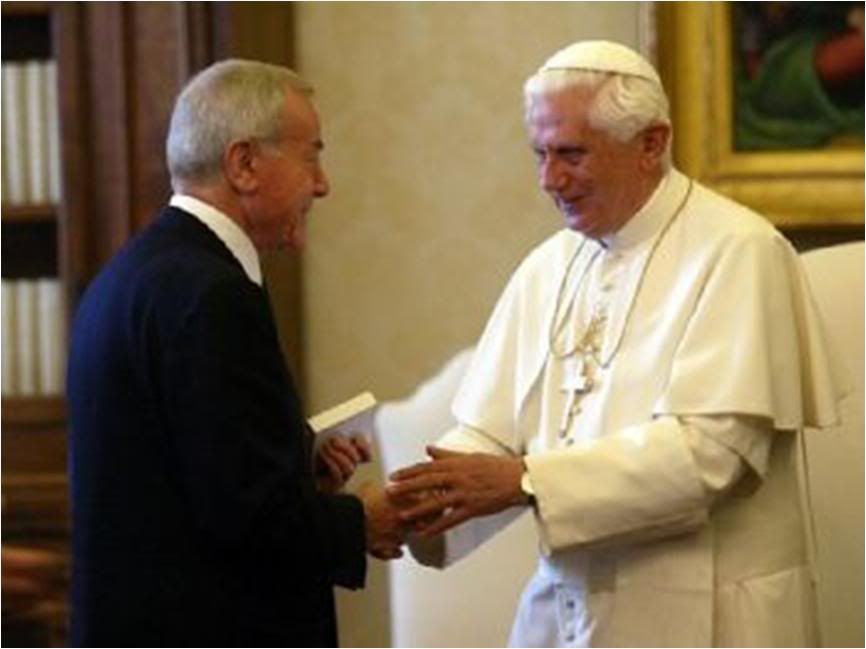 A deep and fecund osmosis
A deep and fecund osmosis
between Church and State
by Gianni Letta
Since he was elected to the Papacy in April 2005, to the present, His Holiness, Benedict XVI, has visited, during 16 pastoral visits, twenty towns and cities in the peninsula, meeting millions of Italians and receiving from them singular testimony of their veneration and affection.
The presence of the Pope in so many of the places most significant in the history of the Church and for the relation between the Church and the people of our country testifies to the fact that the Pontiff, besides being the leader of the Universal Church and Bishop of Rome, is also the Primate of Italy.
The link of the Papacy with the city of Rome, from Peter and his first successors, has been and is a most important and solemn characteristic of the papacy, but so is that with Italy as a whole, for which the nation is very proud.
The profound attachment which our present Pope has for our country was clearly expressed on the occasion of his visit to the Quirinale [presidential palace] on October 4, 2008:
"Today," he said, "we can say with satisfaction that in the city of Rome, the Italian State and the Holy See co-exist peacefully and work together fruitfully... The Vatican and the Quirinal are not hills which ignore or confront each other with resentment. They are places that symbolize the reciprocal respect for the sovereignty of Church and State, ready to cooperate together to promote and serve the integral good of the human being as well as peaceful social coexistence".
The absolute exceptionality of the level of relations with Italy and the collaboration between Church and State is underscored by the Pope Himself who points to Italy as a model that other States can follow in this respect.
The Italian model, Benedict XVI has said, is "a positive reality that is verifiable on a daily basis and on different levels, one that other States can look to for useful lessons".
Italy has an exceptional situation from which it has been learning progressively to derive the maximum advantage: We are a secular state in the heart of which beats the Vatican state - the smallest of states but one that has the most universal of vocations.
The Holy See recognizes the secularity of the Italian State, but does not step back - and this comforts us - from a most important role in forming the consciences of Italians.
The words that Benedict XVI has often said about this are exemplary: "The Church is not and does not intend to be a political agent... It does have a profound interest for the good of the community.. The immediate task of acting in political terms to construct a just order in society is therefore not that of the Church as such, but of its lay faithful acting as citizens of their own responsibility. It is a task of the greatest importance, to which lay Italian Christians are called on to dedicate themselves with courage and generosity".
In fact, one cannot fail to acknowledge the social and public dimension of the religious reality, and its great and important contribution to the consolidation of those values which - for the good of everyone, believers and non-believers - should orient our society and support the entire institutional structure.
From these brief statements on the role of the Church in Italian society, it emerges quite clearly that, in full respect of their respective autonomies - often reiterated by Benedict XVI in his homilies and encyclicals - collaboration between Church and State, especially in a country like Italy, can lead to the achievement of goals that are important "for the edification of a society founded on truth adn freedom, on respect for life and human dignity, on justice and on social solidarity".
The Pope's visits throughout Italy, which I have had the privilege of joining many times, have allowed us to feel at first hand this deep-running and fruitful osmosis between Church and State, and to see so many cities had historic places in a completely different light from usual.
We have seen cities cleaned and beautified with care and love. We have seen public works brought to completion in record time, in order to offer the Holy Father the best aspects of the places he is visiting.
Above all, we have seen people who are happy and festive, young and old, together in their expectations and deeply touched by the singular privilege Italians have of being able to see and hear first-hand the Successor of Peter with a frequency and familiarity that are unique in the world.
|
| |
 08/11/2009 02:47 08/11/2009 02:47 |
|
| | | OFFLINE | | Post: 18.820
Post: 1.468 | Registrato il: 28/08/2005
Registrato il: 20/01/2009 | Administratore | Utente Veteran | |
|
 This editorial commentary is on Page 1 of tomorrow's OR. I've translated it, but i find it strangely disjointed.
Paul VI, Benedict XVI and the matrix
This editorial commentary is on Page 1 of tomorrow's OR. I've translated it, but i find it strangely disjointed.
Paul VI, Benedict XVI and the matrix
of the Church's social doctrine
by Fr. Robert P. Imbelli
Translated from
the 11/8/09 issue of
 Caritas in veritate
Caritas in veritate has stirred a great deal of attention for its consequnces on financial questions in a time of economic crisis. Without denying the importance of these considerations, it is essential not to ignore the strictly theological challenges posed by the encyclical.
According to the Pope, in fact, economic interests cannot be separated from that which is definitely the most important for mankind: the divine economy of salvation.
The first characteristic of the encyclical is its reference to the basis of the social doctirne of the Church, namely, the announcement of Jesus Christ.
One consequence of the Christologic orientation of the text is that this doctrine is rooted in the Gospel and not in natural law. Certainly, this does not exclude calling on natural law, which is characteristic of Catholic reflection on social issues.
Indeed, there are specific contexts where it is opportune and even necessary, but the desire to find common ground for all persons of goodwill can unwittingly uproot natural law from the fertile soil that alone is capable of nourishing and sustaining it.
In other words, natural law is an 'abstraction' taken from a catholic language that is by far more exhaustive and profound in expressing a vision of mankind and the world: that of integral humanism, so dear to Paul VI and now confirmed by Benedict XVI.
Indeed, unless this richer catholic language is invoked and used, as the Pope does throughout Caritas in veritate, one risks reducing religion to ethics, to personal relations, to fraternity and the promotion of a cause, no matter how right and desirable such a cause may be.
A second characteristic of the encyclical is its resort to an integral vision of man as once evoked in Populorum progressio. This 'true integral humanism' (No. 78) is a seamless garment that comprehends the individual and the social, body and soul, interest in the earthly city and hope in the celestial city.
It is noteworthy that Benedict XVI has put together in this global view those magisterial texts of Paul VI that are too often ignored by Catholics: Populorum progressio, Humanae vitae and Evangelii nuntiandi - documents which, together, render vigorous testimony of a vision, open to hope, of the human being and his destiny.
This vision of man, traditionally Catholic, is definitely rooted in Christology. Benedict XVI's conviction faithfully reflects the teaching of Gaudium et spes which affirms that "only the mystery of the incarnate Word sheds light on the mystery of man" (No, 22).
Thus, the encylical launches a further challenge to Catholic thought and action. It concerns the need to promote an integral reception of Vatican II and of the four Conciliar constitutions - eahc of which illuminates the other.
Suypporters of Gaudium et spes and its social message should develop the fundamentals for this message in the light of Dei verbum. In turn, the advocates of liturgical reform, which took off from Sacrosanctum concilium, should consider that worship is intimately associated with the testimony called for by Lumen gentium on the Church as 'the sacrament of salvation' for the whole world.
In an address on the annversary of the collapse of Lehman Brothers, the President of the United Sattes said that "it was a failure of responsibility". Of course, in speaking of Wall Street, Obama could not use the word conversion.
But the Pope can say out loud what politicians can only say in whispers. Necessary structural change cannot substitute for authentic conversion of the heart and mind.
Sut since conversion is a permanent imperative, the social doctrine of the Church is complete only when it is incarnated in a spirituality which nourisnes its commitment to charity in truth.
This spirituality "places man before the stupefying experience of giving" and promotes the realization of the 'gratuitousness present in his life in many forms" (No. 34), and for Catholics, it is always rooted in the Eucharist. In short, the social doctrine derives from and depends on the liturgical and ecclesial matrix and its dogmatic affirmations.
Someone could object: Does not such a reading of the encyclical impede dialog with other traditions and does it not show a sectarian atttiude? I think not. It could instead spur on those who share the propositions and the values of Caritas in veritate to consider the basis of their own beliefs. In this way, dialog can only be more profound (cfr No. 38).
|
| |
|
|
|
|